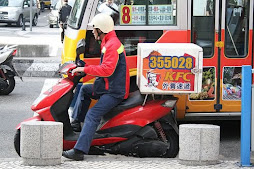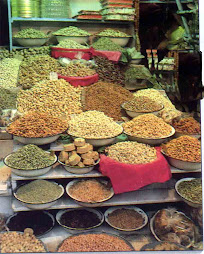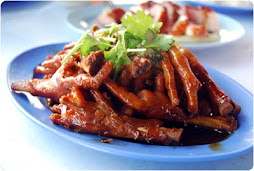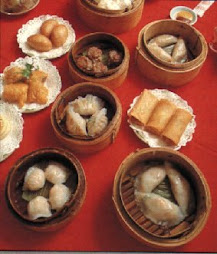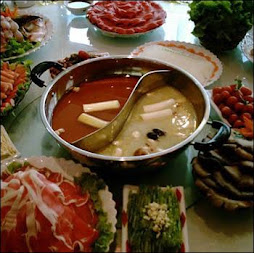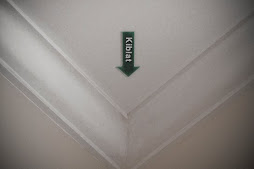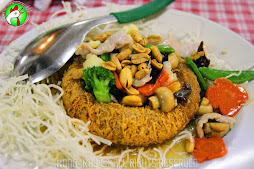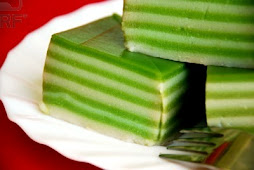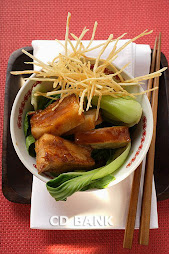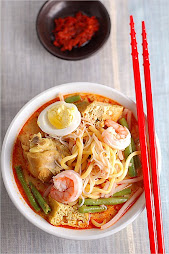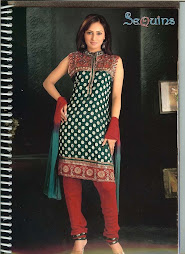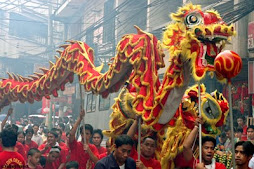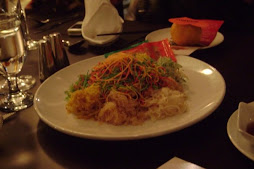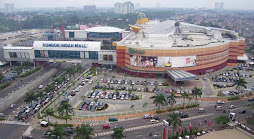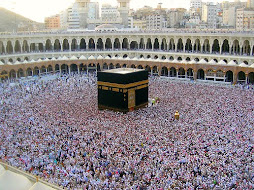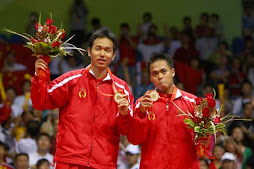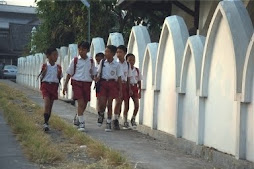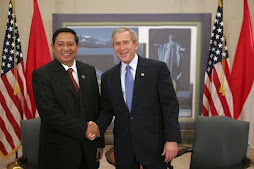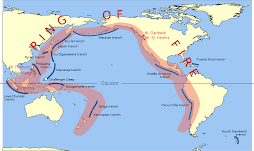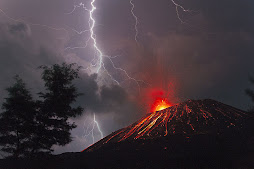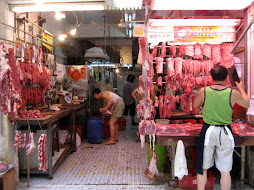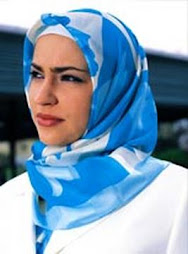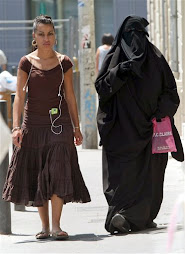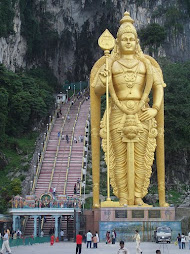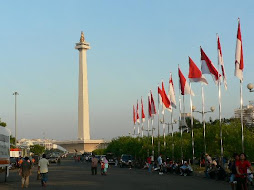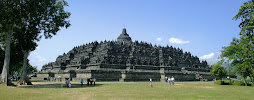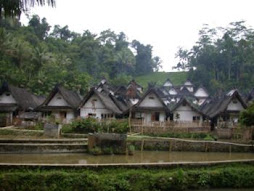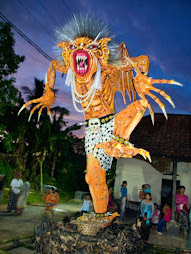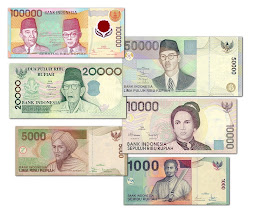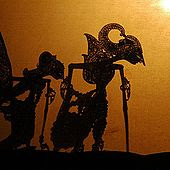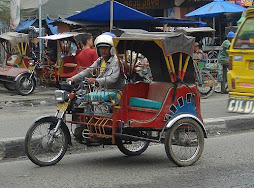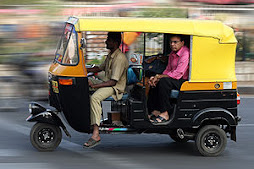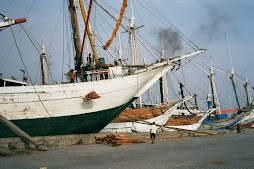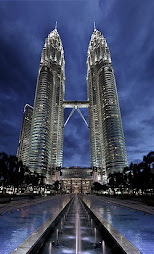What type of fast food can you get and is it the same as you can have here?
ANSWER: The Western World has a huge impact on Asian culture. We have all the same fast food places as home: McDonalds, Pizza Hut, Dominoe's, Burger King, Popeyes, Wendys, Dunkin Donuts, A&W's, KFC, and Baskin Robbins. The difference is that they all deliver to your house (except Dunkin Donuts, Baskin Robbins, and A&W, but I'm sure for the right price they would), most of the time 24 hours a day/7 days a week (see photo). Can you imagine getting McDonalds delivered anytime, day or night? It's pretty cool, especially if you're up late and hungry. Another difference that I'm noticing with these places especially in Indonesia is that KFC doesn't serve mashed potatoes, instead they serve rice (remember how I said rice is a staple with every meal including breakfast). And almost all of the places that serve burgers, also serve fried chicken. I'm hoping one day, somebody will make my dream come true and open up a Taco Bell.
We also have other restaurants that are from the U.S. There is Outback, Chili's, and TGIF. When we're in the mood for a dinner that is familiar and we don't have to worry about if it's going to be spicy or not, we go to one of those.
Sunday, May 16, 2010
Question from Christian
What is the average cost of rent there?
ANSWER: Well, honestly I can only answer this question as an expat. I was recently house hunting and even though the company pays our rent, I wanted to find the perfect house at the right price. We are allocated a certain amount each month for housing and even if our rent is lower than that amount then the company will still pay us the difference which we can use to pay for our utilities, cable, internet, maid, gardener, and security or we can save it.
There are many housing options for expats living in Jakarta. You can choose an apartment and then it could be a serviced apartment where they provide house keeping and laundry service, the apartment could be unserviced but still have amenities such as swimming pool, gym, sauna, restaurant, and security; or you could choose a penthouse which is just a larger, usually 2-leveled apartment. The prices for these usually start at $1000 p/month and can go as high as (depending on the size of your apartment) as $5000 p/month.
If you choose to live in a house, there are several options for that as well. You could have a townhouse that is usually located in a complex with 24 hour security, you could have an individual house that is located in a compound with amenities and 24 hour security, or you could live in an individual house and hire your own private security which is what we chose to do. The prices vary depending on which area you want to live in, the amenities offered, if it's furnished or unfurnished, and how updated the house is. It can average anywhere from $1000 p/month up to $10,000, the higher price of course is more than likely for a mansion so size does matter in the price too. The house I chose is in a good neighborhood, 3 bedrooms, 3 bathrooms, updated kitchen and bathrooms, a front yard, back yard with swimming pool, and is about 3200 sq/feet and our rent is 25 million rupiah p/month or $2500. Keep in mind that most landlords know that expats will be renting their properties so they of course increase the price plus they ask for a full years rent up front plus security deposit, but they know that the company is paying for it so they have no problem doing that.
Of course we would never pay these prices if we were home and I'm sorry I don't know what the locals pay for rent, no matter how much research I did, I could only find numbers for expats cost of living. But I'm happy with the house and can't wait to move in at the end of this month.
ANSWER: Well, honestly I can only answer this question as an expat. I was recently house hunting and even though the company pays our rent, I wanted to find the perfect house at the right price. We are allocated a certain amount each month for housing and even if our rent is lower than that amount then the company will still pay us the difference which we can use to pay for our utilities, cable, internet, maid, gardener, and security or we can save it.
There are many housing options for expats living in Jakarta. You can choose an apartment and then it could be a serviced apartment where they provide house keeping and laundry service, the apartment could be unserviced but still have amenities such as swimming pool, gym, sauna, restaurant, and security; or you could choose a penthouse which is just a larger, usually 2-leveled apartment. The prices for these usually start at $1000 p/month and can go as high as (depending on the size of your apartment) as $5000 p/month.
If you choose to live in a house, there are several options for that as well. You could have a townhouse that is usually located in a complex with 24 hour security, you could have an individual house that is located in a compound with amenities and 24 hour security, or you could live in an individual house and hire your own private security which is what we chose to do. The prices vary depending on which area you want to live in, the amenities offered, if it's furnished or unfurnished, and how updated the house is. It can average anywhere from $1000 p/month up to $10,000, the higher price of course is more than likely for a mansion so size does matter in the price too. The house I chose is in a good neighborhood, 3 bedrooms, 3 bathrooms, updated kitchen and bathrooms, a front yard, back yard with swimming pool, and is about 3200 sq/feet and our rent is 25 million rupiah p/month or $2500. Keep in mind that most landlords know that expats will be renting their properties so they of course increase the price plus they ask for a full years rent up front plus security deposit, but they know that the company is paying for it so they have no problem doing that.
Of course we would never pay these prices if we were home and I'm sorry I don't know what the locals pay for rent, no matter how much research I did, I could only find numbers for expats cost of living. But I'm happy with the house and can't wait to move in at the end of this month.
Question from jabari
You talked about the spices used there, what is the most popular spice to put into food?
ANSWER: Indonesia is known for cloves and nutmeg and was the reason for so many ancient wars, over who would control the Spice Islands. First it was dominated by Chinese, Indian and Arab merchants then the Europeans came to Indonesia looking for cloves and nutmeg since it was widely used by women to freshen their breath, men used to put in drinks and also it was used for medicinal purposes like for the treatment of rheumatism, gout, and colic. When the Europeans arrived, Indonesia was controlled by Portuguese and they were fighting the Spaniards who were fighting the natives. Eventually everyone lost, and Indonesia was ruled by the Dutch from 1605-1945 when Indonesia gained its independence.
Indonesia taught the world the use of exotic spices and herbs. Indonesian cuisine is known for its deliberate combination of contrasting flavors (spicy, sour, sweet, hot) and textures (wet, coarse, spongy, hard). Indonesian saffron (kunyit) is used to color rice dishes an intense yellow and provide rice with spicy flavoring. Terasi, a red-brown fermented shrimp paste with a potent aroma, is used in small amounts in most sauces. It's considered absolutely essential to a successful rijstaffel (smorgasboard). There are many kinds of hot chili pastes (sambal) invariably made from red chilies, shallots, and tomatoes. So, really there really isn't just one popular spice that's used in Indonesia, it's the combination of the spices that give Indonesian dishes their unique flavor.
ANSWER: Indonesia is known for cloves and nutmeg and was the reason for so many ancient wars, over who would control the Spice Islands. First it was dominated by Chinese, Indian and Arab merchants then the Europeans came to Indonesia looking for cloves and nutmeg since it was widely used by women to freshen their breath, men used to put in drinks and also it was used for medicinal purposes like for the treatment of rheumatism, gout, and colic. When the Europeans arrived, Indonesia was controlled by Portuguese and they were fighting the Spaniards who were fighting the natives. Eventually everyone lost, and Indonesia was ruled by the Dutch from 1605-1945 when Indonesia gained its independence.
Indonesia taught the world the use of exotic spices and herbs. Indonesian cuisine is known for its deliberate combination of contrasting flavors (spicy, sour, sweet, hot) and textures (wet, coarse, spongy, hard). Indonesian saffron (kunyit) is used to color rice dishes an intense yellow and provide rice with spicy flavoring. Terasi, a red-brown fermented shrimp paste with a potent aroma, is used in small amounts in most sauces. It's considered absolutely essential to a successful rijstaffel (smorgasboard). There are many kinds of hot chili pastes (sambal) invariably made from red chilies, shallots, and tomatoes. So, really there really isn't just one popular spice that's used in Indonesia, it's the combination of the spices that give Indonesian dishes their unique flavor.
Question from Isela
Have you been to any interesting restaurants in Asia?
ANSWER: We have been to many interesting places to eat in Asia. I think what makes them interesting is the food that they serve although a couple have offered us different dining experiences. One of the first different experiences we had was when we visited Shanghai, China. It was a place called the Hot Pot (see photo), the Chinese friends that took us did all of the ordering for us and the wait staff brought over a large pot that had 2 sections filled with different broths. This pot was over a burner to heat the broth and then the wait staff brought us various raw meats and vegetables and we could choose the ones we wanted to cook ourselved in the broth. Then once the meat and vegetables are finished cooking, you fish them out with your chopsticks and dip them in a spicy peanut sauce. It was a fun experience and tasty!
My husband and I have grown fond of dim sum also. This is a type of Chinese dish that involves small individual portions of food, usually served in a small steamer basket or on a small plate (see photo). Dim sum is traditionally served at tea time (early afternoon) and is a perfect snack to hold you over before dinner. Dim sum can be many different things, but usually it's a steamed dumpling filled with either pork, shrimp, or vegetables and it's of course served with Chinese tea. In addition to the dumplings there's also buns filled with BBQ pork called Bau, rice noodles, meatballs, spare ribs, spring rolls, and chicken feet. The chicken feet are called Phoenix Talons and they are deep fried, then boiled, then marinated in a black bean sauce, then steamed; a lot of people eat chicken feet for breakfast, me personally I don't think they have enough meat on them (see photo). In addition, there are also cakes and pudding for dessert. Even though it's custom to eat dim sum at tea time or early in the morning, there are many restaurants who serve it for dinner as well.
Even though I've tried different foods since living in Asia, and have been to many restaurants, nothing beats a good hawker stall or hawker center. I've mentioned the numerous street peddlars here in Jakarta but in Malaysia, Singapore and Shanghai, they are called hawkers and an area where there are many hawkers it called a hawker center (see photo), in Jakarta they are called Warungs (wah-roongs). These are people who have been selling their food on the streets for generations and use their family's or village's recipes. Some of the best food I've had comes from these places. I haven't tried any yet in Jakarta, I'll wait until we move into our permanent house and then find one with good food and is somewhat clean.
ANSWER: We have been to many interesting places to eat in Asia. I think what makes them interesting is the food that they serve although a couple have offered us different dining experiences. One of the first different experiences we had was when we visited Shanghai, China. It was a place called the Hot Pot (see photo), the Chinese friends that took us did all of the ordering for us and the wait staff brought over a large pot that had 2 sections filled with different broths. This pot was over a burner to heat the broth and then the wait staff brought us various raw meats and vegetables and we could choose the ones we wanted to cook ourselved in the broth. Then once the meat and vegetables are finished cooking, you fish them out with your chopsticks and dip them in a spicy peanut sauce. It was a fun experience and tasty!
My husband and I have grown fond of dim sum also. This is a type of Chinese dish that involves small individual portions of food, usually served in a small steamer basket or on a small plate (see photo). Dim sum is traditionally served at tea time (early afternoon) and is a perfect snack to hold you over before dinner. Dim sum can be many different things, but usually it's a steamed dumpling filled with either pork, shrimp, or vegetables and it's of course served with Chinese tea. In addition to the dumplings there's also buns filled with BBQ pork called Bau, rice noodles, meatballs, spare ribs, spring rolls, and chicken feet. The chicken feet are called Phoenix Talons and they are deep fried, then boiled, then marinated in a black bean sauce, then steamed; a lot of people eat chicken feet for breakfast, me personally I don't think they have enough meat on them (see photo). In addition, there are also cakes and pudding for dessert. Even though it's custom to eat dim sum at tea time or early in the morning, there are many restaurants who serve it for dinner as well.
Even though I've tried different foods since living in Asia, and have been to many restaurants, nothing beats a good hawker stall or hawker center. I've mentioned the numerous street peddlars here in Jakarta but in Malaysia, Singapore and Shanghai, they are called hawkers and an area where there are many hawkers it called a hawker center (see photo), in Jakarta they are called Warungs (wah-roongs). These are people who have been selling their food on the streets for generations and use their family's or village's recipes. Some of the best food I've had comes from these places. I haven't tried any yet in Jakarta, I'll wait until we move into our permanent house and then find one with good food and is somewhat clean.
Question from Hank
Do you know the countries GDP?
ANSWER: Indonesia's nominal GDP is forecast to be US 614.55 billion for 2010. This is contributed to retail sales, tourism, and food consumption as well as exportation of oil products and agriculture. Average annual GDP growth of 5.6% is predicted through to 2014 since the population is also anticipated to rise to 250 million people by 2014. Indonesia has one of the largest economies in S.E. Asia and is one of the emerging market economies of the world.
Malaysia's GDP as of 2009 was US 381.1 billion. This is contributed to agriculture, export of rubber, oil products, timber, palm oil and the manufacture and export of electronics and electrical equipment to the U.S., Malaysia's principal trade and investment partner. Malaysia is ranked 24th in terms of world oil reserves and 13th for natural gas.
ANSWER: Indonesia's nominal GDP is forecast to be US 614.55 billion for 2010. This is contributed to retail sales, tourism, and food consumption as well as exportation of oil products and agriculture. Average annual GDP growth of 5.6% is predicted through to 2014 since the population is also anticipated to rise to 250 million people by 2014. Indonesia has one of the largest economies in S.E. Asia and is one of the emerging market economies of the world.
Malaysia's GDP as of 2009 was US 381.1 billion. This is contributed to agriculture, export of rubber, oil products, timber, palm oil and the manufacture and export of electronics and electrical equipment to the U.S., Malaysia's principal trade and investment partner. Malaysia is ranked 24th in terms of world oil reserves and 13th for natural gas.
Question from Jackie
Do they read the same direction that we do?
ANSWER: Ok, not sure if I'm reading this correctly but if you mean like reading books and magazines, then yes, they read in the same direction as we do. I know in some languages like Hebrew, which reads from right to left, and Mandarin, which reads vertically, but Bahasa Indonesia reads left to right just like at home. Since Indonesia is a former Dutch colony, they also have the same alphabet as we do but the letters are pronounced differently.
If you meant in terms of direction, then, they use North, South, East, and West as well.
ANSWER: Ok, not sure if I'm reading this correctly but if you mean like reading books and magazines, then yes, they read in the same direction as we do. I know in some languages like Hebrew, which reads from right to left, and Mandarin, which reads vertically, but Bahasa Indonesia reads left to right just like at home. Since Indonesia is a former Dutch colony, they also have the same alphabet as we do but the letters are pronounced differently.
If you meant in terms of direction, then, they use North, South, East, and West as well.
Question from LaDorria
What is the health care like there?
ANSWER: Well, to put it simply: it's lacking. Basicly, if you can afford good healthcare then you can go to acredited hospitals where the staff of doctors have more than likely trained overseas. If you can not afford to go to these hospitals then there are many clinics that offer treatment but it's not guaranteed that you'll be diagnosed correctly or treated properly. They say most of the doctors who operate in such clinics have bought their medical degrees and the methods in which they practice are outdated. As of now, there are no government sponsored programs so people either receive poor treatment or medicate themselves, this is true for those who live in rural areas where clinics are few. A lot of people who can afford good treatment choose to travel to Singapore or Malaysia, believing that the doctors and facilities are modern and techniques are up to date. The government is planning over the next 4 years to implement a system for the poor, elderly and disabled but people are again doubting the quality of care that they will receive. The hospital that I plan on using is very modern and clean and so far I have no doubts that I will receive adequate care for my diabetes. I recently went to a dentist to have a tooth pulled and I must say that it was probably the best experience I've ever had at a dentist's office. The office was clean and used modern techniques and the cost was cheaper than what I would have paid in the U.S., only $100. But if you're local and you only make $150 p/month, then you would not choose this office since it's considered expensive.
There are community organizations that sponsor clinics here. On my trip to Medan, Indonesia, I was with my Malaysian friend and her mother who is a member of the Rotary Club. We stopped in a village so that we could dedicate a free clinic to the community. I must say, even though I had nothing to do with the clinic itself, it was a good feeling leaving there and knowing that the people would have access to a doctor and a dentist free of charge. As a matter of fact, my friend Sim was their very first dental patient since she had her wisdom pulled before the trip and she was very swollen so the dentist had a look (see photo).
ANSWER: Well, to put it simply: it's lacking. Basicly, if you can afford good healthcare then you can go to acredited hospitals where the staff of doctors have more than likely trained overseas. If you can not afford to go to these hospitals then there are many clinics that offer treatment but it's not guaranteed that you'll be diagnosed correctly or treated properly. They say most of the doctors who operate in such clinics have bought their medical degrees and the methods in which they practice are outdated. As of now, there are no government sponsored programs so people either receive poor treatment or medicate themselves, this is true for those who live in rural areas where clinics are few. A lot of people who can afford good treatment choose to travel to Singapore or Malaysia, believing that the doctors and facilities are modern and techniques are up to date. The government is planning over the next 4 years to implement a system for the poor, elderly and disabled but people are again doubting the quality of care that they will receive. The hospital that I plan on using is very modern and clean and so far I have no doubts that I will receive adequate care for my diabetes. I recently went to a dentist to have a tooth pulled and I must say that it was probably the best experience I've ever had at a dentist's office. The office was clean and used modern techniques and the cost was cheaper than what I would have paid in the U.S., only $100. But if you're local and you only make $150 p/month, then you would not choose this office since it's considered expensive.
There are community organizations that sponsor clinics here. On my trip to Medan, Indonesia, I was with my Malaysian friend and her mother who is a member of the Rotary Club. We stopped in a village so that we could dedicate a free clinic to the community. I must say, even though I had nothing to do with the clinic itself, it was a good feeling leaving there and knowing that the people would have access to a doctor and a dentist free of charge. As a matter of fact, my friend Sim was their very first dental patient since she had her wisdom pulled before the trip and she was very swollen so the dentist had a look (see photo).
Questions from Alejandro
What is the most popular television show?
ANSWER: This question was a tough one since I don't watch local television, mainly because I can't understand it. I usually only watch the English speaking channels, so I had to do some research. I have a friend back in Malaysia who is Indonesian and she gave me the names of her favorite programs and that's where I started. It seems reality television is really big over here and the programs are modeled after American reality shows. I can watch American Idol here, but can't vote (I'm rooting for Crystal Bowersox and Lee, doesn't matter since they both will have records next year) and it seems to be popular with the locals as well. There is Indonesian Idol and I've watched it once, the performers were good and the judges were like Indonesian versions of Randy, Ellen, Kara and Simon.
There are 79 Indonesian reality shows, most copycats of American programming. Reality shows have dominated the ratings surpassing soap operas which used to top the charts. The most high ranking one is called Termehek-Mehek which roughly translates to Sobbing. This show reunites people from long lost relatives to wives abandoned by husbands-often in highly emotional and often confrontational environments. Another show, called Jika Aku Menjadi or If I Were, takes middle-class or wealthy people and puts them in a rural area of Indonesia; kind of like The Simple Life with Paris Hilton but without celebrities. And there's Tukar Nasib or Fate Swap where rich families switch places with poor families, sort of like Wife Swap.
The reality shows represent another chapter in the evolution of Indonesian television. During former president Suharto's dictatorship, television stations were only allowed to show the military governments point of view, except for news, there was little original content. The American shows gave way to additional local programming as well as less politically sensitive shows. Funny thing is that most people don't realize that their favorite tv shows are very much American.
ANSWER: This question was a tough one since I don't watch local television, mainly because I can't understand it. I usually only watch the English speaking channels, so I had to do some research. I have a friend back in Malaysia who is Indonesian and she gave me the names of her favorite programs and that's where I started. It seems reality television is really big over here and the programs are modeled after American reality shows. I can watch American Idol here, but can't vote (I'm rooting for Crystal Bowersox and Lee, doesn't matter since they both will have records next year) and it seems to be popular with the locals as well. There is Indonesian Idol and I've watched it once, the performers were good and the judges were like Indonesian versions of Randy, Ellen, Kara and Simon.
There are 79 Indonesian reality shows, most copycats of American programming. Reality shows have dominated the ratings surpassing soap operas which used to top the charts. The most high ranking one is called Termehek-Mehek which roughly translates to Sobbing. This show reunites people from long lost relatives to wives abandoned by husbands-often in highly emotional and often confrontational environments. Another show, called Jika Aku Menjadi or If I Were, takes middle-class or wealthy people and puts them in a rural area of Indonesia; kind of like The Simple Life with Paris Hilton but without celebrities. And there's Tukar Nasib or Fate Swap where rich families switch places with poor families, sort of like Wife Swap.
The reality shows represent another chapter in the evolution of Indonesian television. During former president Suharto's dictatorship, television stations were only allowed to show the military governments point of view, except for news, there was little original content. The American shows gave way to additional local programming as well as less politically sensitive shows. Funny thing is that most people don't realize that their favorite tv shows are very much American.
Question from Natalie
Can only expats show at the grocery stores?
ANSWER: No, anyone can shop at the grocery store, it's just a matter of IF they can afford it. The prices in the grocery store are much more expensive than if people shopped at the wet markets. Plus processed foods arent' very popular with Indonesians since most of them cook everything fresh themselves. Remember I said that most people's monthly income is around $200 U.S. and if I can spend $100 for one weeks worth of food for only 2 people at a a grocery store, imagine how much a local, who makes much less than we do, can buy at a grocery store.
ANSWER: No, anyone can shop at the grocery store, it's just a matter of IF they can afford it. The prices in the grocery store are much more expensive than if people shopped at the wet markets. Plus processed foods arent' very popular with Indonesians since most of them cook everything fresh themselves. Remember I said that most people's monthly income is around $200 U.S. and if I can spend $100 for one weeks worth of food for only 2 people at a a grocery store, imagine how much a local, who makes much less than we do, can buy at a grocery store.
Question from Marley
Do a lot of tourist come to Indonesia?
ANSWER: Tourism in Indonesia is an important component of the Indonesian economy as well as a significant source of its foreign exchange revenues. It is reported that over 7 million people visited Indonesia in 2009. The draw for tourists of course is the numerous white sand beaches, tropical weather and resorts. Indonesia has some of the best diving spots in the world with over 17,000 islands as well as world class surfing spots. This combined with the national parks, volcanoes and rainforests offer tourists a complete eco-friendly, well preserved nature experience.
Most people who visit, go to Bali and Jakarta or the Thousand Islands. With over 300 ethnic groups tourists also get to experience a cultural lesson as well. Golfing is also big in Indonesia so there are many golf courses and even my husband's first visit to Indonesia was so he could play. My first visit here was to Medan and to visit Lake Toba in northern Sumatra. Lake Toba is the largest volcanic lake in the world and is known as the home of the largest volcanic eruption on Earth in the last 25 million years. It's a very beautiful place (see photo) and the journey to get the lake was very interesting, driving through different small towns, seeing volcanoes (see photo) and even battling traffic. I would compare it to Lake Tahoe but on a grander scale. If you're ever in Indonesia, it's not to be missed.
ANSWER: Tourism in Indonesia is an important component of the Indonesian economy as well as a significant source of its foreign exchange revenues. It is reported that over 7 million people visited Indonesia in 2009. The draw for tourists of course is the numerous white sand beaches, tropical weather and resorts. Indonesia has some of the best diving spots in the world with over 17,000 islands as well as world class surfing spots. This combined with the national parks, volcanoes and rainforests offer tourists a complete eco-friendly, well preserved nature experience.
Most people who visit, go to Bali and Jakarta or the Thousand Islands. With over 300 ethnic groups tourists also get to experience a cultural lesson as well. Golfing is also big in Indonesia so there are many golf courses and even my husband's first visit to Indonesia was so he could play. My first visit here was to Medan and to visit Lake Toba in northern Sumatra. Lake Toba is the largest volcanic lake in the world and is known as the home of the largest volcanic eruption on Earth in the last 25 million years. It's a very beautiful place (see photo) and the journey to get the lake was very interesting, driving through different small towns, seeing volcanoes (see photo) and even battling traffic. I would compare it to Lake Tahoe but on a grander scale. If you're ever in Indonesia, it's not to be missed.
Question from Joseph
Was the transition between the two countries difficult?
ANSWER: Well, I still consider myself in transition, but the move to Malaysia was much easier than Indonesia has been. Majority of the people here do not speak English so I have been learning their language...slowly. Eventually, once we move into our permanent house I will be taking full time classes and I'm sure that will help me out tremendously.
Also, in Malaysia, it was very easy to just go to a certain neighborhood and walk around and explore. That is proving more difficult here in Jakarta. Since most areas I see look like slums, it's hard to determine where it's safe for me to walk around and I've been advised not to walk around by myself at night anywhere.
Kuala Lumpur is a very clean metropolis city and feels very safe. Here, I'm not sure how safe I am even though everything I read says that I'm safer here than I would be at home. Jakarta is not very clean, you can't drink the tap water so even if I see a street peddlar who I want to buy a snack from, I can't communicate with him plus I'm not sure if I'll become sick after eating it. Normally I'm adventurous and just wouldn't care, but maybe perhaps I'm getting older and taking more precautions. Plus the threat of terrorist attacks is much greater here than Malaysia, everwhere you go there are security checks, even to get into the mall parking lot. The security guards use a mirror to check under the car and the driver has to open the trunk for inspection so that even adds to my caution. There are pickpockets in both countries so of course from living in Malaysia and being pickpocketed once, I'm always extremely careful with my purse.
I think once I have a better understanding of the language and I'm able to communicate more, the transition will be easier. Not to mention, when we move, I'll have a full time driver so he can spend his days driving me to places I probably wouldn't go to in a taxi, just because I'll know that someone is waiting for me to return.
ANSWER: Well, I still consider myself in transition, but the move to Malaysia was much easier than Indonesia has been. Majority of the people here do not speak English so I have been learning their language...slowly. Eventually, once we move into our permanent house I will be taking full time classes and I'm sure that will help me out tremendously.
Also, in Malaysia, it was very easy to just go to a certain neighborhood and walk around and explore. That is proving more difficult here in Jakarta. Since most areas I see look like slums, it's hard to determine where it's safe for me to walk around and I've been advised not to walk around by myself at night anywhere.
Kuala Lumpur is a very clean metropolis city and feels very safe. Here, I'm not sure how safe I am even though everything I read says that I'm safer here than I would be at home. Jakarta is not very clean, you can't drink the tap water so even if I see a street peddlar who I want to buy a snack from, I can't communicate with him plus I'm not sure if I'll become sick after eating it. Normally I'm adventurous and just wouldn't care, but maybe perhaps I'm getting older and taking more precautions. Plus the threat of terrorist attacks is much greater here than Malaysia, everwhere you go there are security checks, even to get into the mall parking lot. The security guards use a mirror to check under the car and the driver has to open the trunk for inspection so that even adds to my caution. There are pickpockets in both countries so of course from living in Malaysia and being pickpocketed once, I'm always extremely careful with my purse.
I think once I have a better understanding of the language and I'm able to communicate more, the transition will be easier. Not to mention, when we move, I'll have a full time driver so he can spend his days driving me to places I probably wouldn't go to in a taxi, just because I'll know that someone is waiting for me to return.
Question from Joseph
Have you come across a Muslim praying outside? If so, what is the proper way to be respectful of their prayer?
ANSWER: This is probably unlikely considering that I've lived in large cities. Most mosques lie behind walls and gates and in public areas, prayer rooms are provided, no matter where you go; in all the airports, shopping malls, schools etc. The gates surrounding the mosques provide two barriers, offering privacy to those practicing inside and also for the outsiders who wish to enter, the gates indicate that beyond that point everyone must be properly dressed. Even in private homes, some people have a designated area for prayers or at least something that points the way to Mecca and the Ka'bah. Even when you stay in hotels in Asia, if you look at the ceiling or in one of the drawers, most likely you'll find an arrow pointing the way (see photo). I even have a small pagoda outside my temporary house that can be used for prayer (see photo). I would believe that it would only be in rural areas where you would come across someone praying in an undesignated area and then I would just quietly pass by and let them continue, do not disturb them. I have an Aunt who is Muslim, she converted before marrying my Uncle, such is the way when you have 2 people of different religions who wish to marry, one must convert. When I would visit her, during their prayer times, her family would go down to the basement and pray. She would just say where she was going and we all understood. You are always welcomed to enter a mosque as long as you are dressed appropiately and in most of the larger mosques, you may ask questions so you can better understand.
ANSWER: This is probably unlikely considering that I've lived in large cities. Most mosques lie behind walls and gates and in public areas, prayer rooms are provided, no matter where you go; in all the airports, shopping malls, schools etc. The gates surrounding the mosques provide two barriers, offering privacy to those practicing inside and also for the outsiders who wish to enter, the gates indicate that beyond that point everyone must be properly dressed. Even in private homes, some people have a designated area for prayers or at least something that points the way to Mecca and the Ka'bah. Even when you stay in hotels in Asia, if you look at the ceiling or in one of the drawers, most likely you'll find an arrow pointing the way (see photo). I even have a small pagoda outside my temporary house that can be used for prayer (see photo). I would believe that it would only be in rural areas where you would come across someone praying in an undesignated area and then I would just quietly pass by and let them continue, do not disturb them. I have an Aunt who is Muslim, she converted before marrying my Uncle, such is the way when you have 2 people of different religions who wish to marry, one must convert. When I would visit her, during their prayer times, her family would go down to the basement and pray. She would just say where she was going and we all understood. You are always welcomed to enter a mosque as long as you are dressed appropiately and in most of the larger mosques, you may ask questions so you can better understand.
Question from Desmond
Are the shoes the same there as they are in the US due to the different weather?
ANSWER: Believe it or not, Nope. Even though the weather is hot and most people wear sandals and flip flops, they even sell boots and tennis shoes. Asian majority may not make as much as Americans but they do love brand names. I just bought some Chuck Taylors and my husband some Reeboks. But you do a lot more people wearing open toed shoes than compared to the U.S. Of course for professionals, they wear dress shoes and heels just like at home. So I'm sorry to disappoint you but I don't see any differences other than the frequency that they wear sandals, after all, they don't have cold weather to worry about.
ANSWER: Believe it or not, Nope. Even though the weather is hot and most people wear sandals and flip flops, they even sell boots and tennis shoes. Asian majority may not make as much as Americans but they do love brand names. I just bought some Chuck Taylors and my husband some Reeboks. But you do a lot more people wearing open toed shoes than compared to the U.S. Of course for professionals, they wear dress shoes and heels just like at home. So I'm sorry to disappoint you but I don't see any differences other than the frequency that they wear sandals, after all, they don't have cold weather to worry about.
Question from Joey
What is your favorite new food that you have discovered?
ANSWER: Ok, so when I lived at home I loved Ramen noodles, you know the cheap ones you can buy like 10 packages for a dollar? Well, living in Asia they have taken noodles to completely new level!! One of my favorites is called curry laksa (see photo) and it's a noodle soup made with coconut milk, chili, lemongrass, cilantro and whatever else you can throw into it. It's a little spicy but I've gotten used to it...it is soooooo good!
Another food that I've grown to love is deep fried pork belly (don't be shocked, pork belly is just unsliced bacon so you know it has to be good!). At first I didn't know that it was bacon so I was a little scared but after tasting it I was hooked. The top of it is crunchy like a pork rind and then the meat is very juicy like a stack of bacon. I have learned how to make this one and have even BBQ'd one with great results! (see photo)
Even though I'm diabetic, I occassionally get a sweet tooth and the one dessert I found that hits the spot is pandan layer cake (see photo). Pandan is actually a plant, we would call it screwpine leaves and the cake is made from the essence or juice of this plant along with some coconut milk and flour and lots of eggs. It's not that sweet, it's just right, so it cures my sweet tooth. The green layers are the made from the pandan leaves and is like sponge cake, the whiter layers are actually called kaya layers or coconut jam. This is one dessert I always bring home with me for everyone to try!
One of my favorite Chinese dishes but can't find yet in Indonesia is a yam basket. They mash up yams and form a bowl out of it and then deep fry it, then they fill it with various meats and vegetables. It's both sweet and savoury and very healthy even though it's deep fried. (see photo)
ANSWER: Ok, so when I lived at home I loved Ramen noodles, you know the cheap ones you can buy like 10 packages for a dollar? Well, living in Asia they have taken noodles to completely new level!! One of my favorites is called curry laksa (see photo) and it's a noodle soup made with coconut milk, chili, lemongrass, cilantro and whatever else you can throw into it. It's a little spicy but I've gotten used to it...it is soooooo good!
Another food that I've grown to love is deep fried pork belly (don't be shocked, pork belly is just unsliced bacon so you know it has to be good!). At first I didn't know that it was bacon so I was a little scared but after tasting it I was hooked. The top of it is crunchy like a pork rind and then the meat is very juicy like a stack of bacon. I have learned how to make this one and have even BBQ'd one with great results! (see photo)
Even though I'm diabetic, I occassionally get a sweet tooth and the one dessert I found that hits the spot is pandan layer cake (see photo). Pandan is actually a plant, we would call it screwpine leaves and the cake is made from the essence or juice of this plant along with some coconut milk and flour and lots of eggs. It's not that sweet, it's just right, so it cures my sweet tooth. The green layers are the made from the pandan leaves and is like sponge cake, the whiter layers are actually called kaya layers or coconut jam. This is one dessert I always bring home with me for everyone to try!
One of my favorite Chinese dishes but can't find yet in Indonesia is a yam basket. They mash up yams and form a bowl out of it and then deep fry it, then they fill it with various meats and vegetables. It's both sweet and savoury and very healthy even though it's deep fried. (see photo)
Question from Triston
Have you had any interesting experiences in the wet market?
ANSWER: I think walking into any wet market is an experience for any American! Just the culture shock alone is enough to deal with. Yes, I'm sure those Americans who live in a farming environment wouldn't be so shocked by a wet market (my only family has a farm that I used to spend summers at I regularly saw my Aunt kill chickens and saw cows being slaughtered) but it does take some getting used to. Once you get past the smell of fresh meat and fish, it's really not all that different from a farmer's market. I think the one thing that struck me strongly was that knowing people WILL eat just about any part of an animal possible. I've seen all kinds of cuts of meat that normally I would not recognize. It's all there for someone to choose and take home. I don't recommend it if you have a squeamish tummy or you really love animals. The last time I was in a wet market was in Singapore with my friend from Chicago and he loves exotic food and this is the perfect place to buy it. I couldn't help snapping a photo of a pig's tongue while we picked out what we were going to eat for breakfast (see photo) heehee! The place we went to was a wet market downstairs and a food court upstairs so don't think that we picked out fresh meat and then cooked it! I remember the first wet market I ever went to was in Shanghai, China and I kinda knew what it was. The appaling moment for me was when I saw a guy that had cages of turtles and cats and I thought he was selling them as pets and I thought out loud "How cute!" until my guide that day said that they were someone's dinner, I almost cried. People will eat ANYTHING!!
ANSWER: I think walking into any wet market is an experience for any American! Just the culture shock alone is enough to deal with. Yes, I'm sure those Americans who live in a farming environment wouldn't be so shocked by a wet market (my only family has a farm that I used to spend summers at I regularly saw my Aunt kill chickens and saw cows being slaughtered) but it does take some getting used to. Once you get past the smell of fresh meat and fish, it's really not all that different from a farmer's market. I think the one thing that struck me strongly was that knowing people WILL eat just about any part of an animal possible. I've seen all kinds of cuts of meat that normally I would not recognize. It's all there for someone to choose and take home. I don't recommend it if you have a squeamish tummy or you really love animals. The last time I was in a wet market was in Singapore with my friend from Chicago and he loves exotic food and this is the perfect place to buy it. I couldn't help snapping a photo of a pig's tongue while we picked out what we were going to eat for breakfast (see photo) heehee! The place we went to was a wet market downstairs and a food court upstairs so don't think that we picked out fresh meat and then cooked it! I remember the first wet market I ever went to was in Shanghai, China and I kinda knew what it was. The appaling moment for me was when I saw a guy that had cages of turtles and cats and I thought he was selling them as pets and I thought out loud "How cute!" until my guide that day said that they were someone's dinner, I almost cried. People will eat ANYTHING!!
Question from Ezekiel
Have you encountered any new traditions in Indonesia or Malaysia?
ANSWER: Well considering that Indonesia and Malaysia are both predominately Muslim, I wouldn't say it's traditions that I've encountered. Other than respecting the call to prayer, you also have to watch the way that you dress especially if you're near a mosque, like tank tops are usually frowned upon as well as shorts (both of which I own plenty of!). Living in Malaysia and having local friends I learned traditions in the Chinese and Indian groups. For instance, at Chinese New Year, it's good luck to wear red, and to give gifts in red envelopes or packaging. Never wear white to a Chinese holiday since it's the color of death for them, never give anything to anyone with your left hand since they assume that you wipe with it after going to the bathroom. Never leave your chopsticks sticking straight up out of your food, lay them next to your plate (they have a little do-hickey so that it doesn't touch the table), and never start eating until the eldest has started. There is also a salad served at Chinese New Year called Lo-Sang (see photo), before you eat it, everyone must dig their chopsticks in and toss it in the air (not too far, it has to land back on the plate so you can eat it), the higher you toss it, the greater your prosperity will be in the coming year. Also symbolizing good luck and fortune in the coming year are Chinese Dragon dances (see photo). These are held all over the city and the world for Chinese New Year and are very fun to watch.
My Indian friend is Sikh and she is descended from Punjab which is a north-western region of India. A lot of their traditions I did not get to witness since I never attended her temple for prayer. She would spend a lot of time there. I know Sikhism can be confused with Hinduism and they are very similar except Sikhs only believe in one God. She would dress the way I do but when she went to temple, she had to wear a punjabi suit (see photo), which are very beautiful and colorful. One tradition she taught me was that when it's someone birthday, they have to have a cake and they must feed a piece to each of their guests for good luck in the coming year.
Also, everywhere in Asia, it is tradition to take your shoes off at someone's house even if they say it's ok to leave them on.
ANSWER: Well considering that Indonesia and Malaysia are both predominately Muslim, I wouldn't say it's traditions that I've encountered. Other than respecting the call to prayer, you also have to watch the way that you dress especially if you're near a mosque, like tank tops are usually frowned upon as well as shorts (both of which I own plenty of!). Living in Malaysia and having local friends I learned traditions in the Chinese and Indian groups. For instance, at Chinese New Year, it's good luck to wear red, and to give gifts in red envelopes or packaging. Never wear white to a Chinese holiday since it's the color of death for them, never give anything to anyone with your left hand since they assume that you wipe with it after going to the bathroom. Never leave your chopsticks sticking straight up out of your food, lay them next to your plate (they have a little do-hickey so that it doesn't touch the table), and never start eating until the eldest has started. There is also a salad served at Chinese New Year called Lo-Sang (see photo), before you eat it, everyone must dig their chopsticks in and toss it in the air (not too far, it has to land back on the plate so you can eat it), the higher you toss it, the greater your prosperity will be in the coming year. Also symbolizing good luck and fortune in the coming year are Chinese Dragon dances (see photo). These are held all over the city and the world for Chinese New Year and are very fun to watch.
My Indian friend is Sikh and she is descended from Punjab which is a north-western region of India. A lot of their traditions I did not get to witness since I never attended her temple for prayer. She would spend a lot of time there. I know Sikhism can be confused with Hinduism and they are very similar except Sikhs only believe in one God. She would dress the way I do but when she went to temple, she had to wear a punjabi suit (see photo), which are very beautiful and colorful. One tradition she taught me was that when it's someone birthday, they have to have a cake and they must feed a piece to each of their guests for good luck in the coming year.
Also, everywhere in Asia, it is tradition to take your shoes off at someone's house even if they say it's ok to leave them on.
Question from Luis
Do you know how important going to school is to the native people?
ANSWER: This question could go either way. I have to speculate exactly what people think are important and what's not important to them. I have to assume that as a parent, you want your children to succeed and in my own father's words: To have more than they had growing up. Education is the key to that, whether it be from a student obtaining a degree or learning a skill that will allow them to support themselves and their family. Some parents may believe that if a child goes to high school then they will be more successful than them especially since it's only mandatory for a child to attend 9 years of school. Some parents may believe that if their child is able to support their family and take care of them then they are successful. I think most people here see successful people as professionals and therefore need an education. Since most of the school programs are government sponsored, it all depends on the means of the family to send their child to school. The entire world is not filled with responsible parents so it's likely that a lot of the children I see on the streets begging, their parents just don't care or are not able to insure that their children go to school.
Sorry if I couldn't be more specific, again, I'm going on my assumptions about people. I personally have not talked to native Indonesians regarding this matter.
ANSWER: This question could go either way. I have to speculate exactly what people think are important and what's not important to them. I have to assume that as a parent, you want your children to succeed and in my own father's words: To have more than they had growing up. Education is the key to that, whether it be from a student obtaining a degree or learning a skill that will allow them to support themselves and their family. Some parents may believe that if a child goes to high school then they will be more successful than them especially since it's only mandatory for a child to attend 9 years of school. Some parents may believe that if their child is able to support their family and take care of them then they are successful. I think most people here see successful people as professionals and therefore need an education. Since most of the school programs are government sponsored, it all depends on the means of the family to send their child to school. The entire world is not filled with responsible parents so it's likely that a lot of the children I see on the streets begging, their parents just don't care or are not able to insure that their children go to school.
Sorry if I couldn't be more specific, again, I'm going on my assumptions about people. I personally have not talked to native Indonesians regarding this matter.
Question from Simone
Do they have large shopping malls like we do here?
ANSWER: Yes they do!! In addition to all of the street peddlars there are malls of different sizes everywhere! They have movie theaters, fast food restaurants, upscale restaurants, arcades, and lots of stores. Many of the stores are the same ones we have in the U.S. : Body Shop, Gap, Levi's, Nine West, and Nike. You wouldn't know you were in Indonesia if you stepped inside a mall.
One of the ones I go to the most is called Pondok Indah Mall (see photo) or PIM. It's actually 2 malls PIM I and PIM II and they are connected by a skybridge between the two. The difference between the malls here in and the ones at home is that most of the malls have grocery stores in them. They all sell the same thing, clothes, shoes, electronics, kid stuff, books, home decor, furniture, sports equipment, and toys. There are actually 2 movie theaters in PIM, one in each mall and the theaters here are nicer than the ones at home. You get an assigned seat when you buy your ticket and the seats are upholstered and recline and have cup holders. We just saw Robin Hood this past weekend and my husband was able to buy beer at the concession stand. The cost of a movie ticket is cheaper too. For the two of us it only cost $10 and that's only because we went on the weekend, during the week, it's only $2.50 p/person unless you buy a ticket in the premiere section and there you will get a blanket and a waiter that comes to your seat. That will cost you $10 p/person no matter when you go.
ANSWER: Yes they do!! In addition to all of the street peddlars there are malls of different sizes everywhere! They have movie theaters, fast food restaurants, upscale restaurants, arcades, and lots of stores. Many of the stores are the same ones we have in the U.S. : Body Shop, Gap, Levi's, Nine West, and Nike. You wouldn't know you were in Indonesia if you stepped inside a mall.
One of the ones I go to the most is called Pondok Indah Mall (see photo) or PIM. It's actually 2 malls PIM I and PIM II and they are connected by a skybridge between the two. The difference between the malls here in and the ones at home is that most of the malls have grocery stores in them. They all sell the same thing, clothes, shoes, electronics, kid stuff, books, home decor, furniture, sports equipment, and toys. There are actually 2 movie theaters in PIM, one in each mall and the theaters here are nicer than the ones at home. You get an assigned seat when you buy your ticket and the seats are upholstered and recline and have cup holders. We just saw Robin Hood this past weekend and my husband was able to buy beer at the concession stand. The cost of a movie ticket is cheaper too. For the two of us it only cost $10 and that's only because we went on the weekend, during the week, it's only $2.50 p/person unless you buy a ticket in the premiere section and there you will get a blanket and a waiter that comes to your seat. That will cost you $10 p/person no matter when you go.
Question from Brooks
What are the police like? are they strict? are there any different punishments?
ANSWER: Ok, this can be a touchy subject since much criticism regarding law enforcement can end you up in trouble. There are plenty of police employed by the city and most of the time when I see them, they are directing traffic or escorting a diplomat, I have never really seen them pull someone over for a traffic stop. The issue with the police is this: most of them are corrupted. They are known for setting up road blocks and stopping those people who they think they can receive a bribe from. The general idea, especially among expatriates is that no matter what you do, legal or illegal, you can pay someone to make it go away. We are required by law to carry our immigration identification with us at all times and if a policeman asks us for it and we don't have it, then we can just pay him instead of going to court. For more serious crimes, people have tried to pay someone and they may succeed or fail. There is a story about a Western guy who killed a street peddlar while driving drunk. He was told that the matter would go away if he paid the paid the family compensation. He tried to bargain the price lower and the family became angry and went to the high court. He bribed the judge and still received 3 years in prison for his crime.
Indonesia is one of 66 countries who still practice capital punishment, this is usually carried out by a firing squad. Most people on death row have been convicted of murder, drug-trafficking and terrorism. There are 119 prisoners on death row as of January of this year with 55 of them being foreigners. There are groups who are trying to get the government to abolish the death penalty since most prisoners wait at least 5 years before the sentence is carried out, some as long as 20. Prison terms are similar to the U.S. for crimes but if you're wealthy, you can live in the lap of luxury even as a prisoner. It was exposed earlier this year how a woman who was serving a 5 year sentence for bribing a prosecutor lived in a cell that had flat screen tv's, maids, personal drivers to deliver things to her, unlimited visits and phone calls, beauty treatments and even had her adopted daughter staying with her along with her nanny all because she bribed people in the prison to allow it.
In addition to the regular police there are also the Sharia police, or as we call them, the moral police. Pretty much their job is to police those Muslims who are violating Islamic Sharia law. These offences could be drinking, unmarried couples sitting alone in the dark, eating pork, adultery, theft and gambling. The punishments for these crimes vary from the accused being required to attend religious lectures all the way up to the death penalty. If you're a married man or woman found guilty of adultery you are stoned to death but only if you confess or 4 men witness the actual act. If you are unmarried and you commit adultery with a married person then you receive 100 lashes.
And then there's the amateur police in Jakarta. These are the random people you see standing in the middle of traffic with a whistle directing traffic, stopping traffic to let other cars cross. They are not officially employed with the city so they rely on "tips" from the cars that they help get through traffic or park. They are present everywhere, my day is not complete if I don't see one.
ANSWER: Ok, this can be a touchy subject since much criticism regarding law enforcement can end you up in trouble. There are plenty of police employed by the city and most of the time when I see them, they are directing traffic or escorting a diplomat, I have never really seen them pull someone over for a traffic stop. The issue with the police is this: most of them are corrupted. They are known for setting up road blocks and stopping those people who they think they can receive a bribe from. The general idea, especially among expatriates is that no matter what you do, legal or illegal, you can pay someone to make it go away. We are required by law to carry our immigration identification with us at all times and if a policeman asks us for it and we don't have it, then we can just pay him instead of going to court. For more serious crimes, people have tried to pay someone and they may succeed or fail. There is a story about a Western guy who killed a street peddlar while driving drunk. He was told that the matter would go away if he paid the paid the family compensation. He tried to bargain the price lower and the family became angry and went to the high court. He bribed the judge and still received 3 years in prison for his crime.
Indonesia is one of 66 countries who still practice capital punishment, this is usually carried out by a firing squad. Most people on death row have been convicted of murder, drug-trafficking and terrorism. There are 119 prisoners on death row as of January of this year with 55 of them being foreigners. There are groups who are trying to get the government to abolish the death penalty since most prisoners wait at least 5 years before the sentence is carried out, some as long as 20. Prison terms are similar to the U.S. for crimes but if you're wealthy, you can live in the lap of luxury even as a prisoner. It was exposed earlier this year how a woman who was serving a 5 year sentence for bribing a prosecutor lived in a cell that had flat screen tv's, maids, personal drivers to deliver things to her, unlimited visits and phone calls, beauty treatments and even had her adopted daughter staying with her along with her nanny all because she bribed people in the prison to allow it.
In addition to the regular police there are also the Sharia police, or as we call them, the moral police. Pretty much their job is to police those Muslims who are violating Islamic Sharia law. These offences could be drinking, unmarried couples sitting alone in the dark, eating pork, adultery, theft and gambling. The punishments for these crimes vary from the accused being required to attend religious lectures all the way up to the death penalty. If you're a married man or woman found guilty of adultery you are stoned to death but only if you confess or 4 men witness the actual act. If you are unmarried and you commit adultery with a married person then you receive 100 lashes.
And then there's the amateur police in Jakarta. These are the random people you see standing in the middle of traffic with a whistle directing traffic, stopping traffic to let other cars cross. They are not officially employed with the city so they rely on "tips" from the cars that they help get through traffic or park. They are present everywhere, my day is not complete if I don't see one.
Question from Chase
Is the birthrate there low due to poverty?
ANSWER: The birth rate in Indonesia appears very stable the last 7 years with each fertile woman averaging 2.31 children. This number has decreased during this time but has always increased but never going above. The quality of life is gradually improving for most meanwhile, control of population growth is carried out through efforts to lower the birth and mortality rate, especially that of infants and children. These efforts in particular have been implemented through family planning programs which also have the purpose of improving the welfare of mother and child. Contraception has become more widespread and effective, making it easier to plan families.
I also think that people are more aware of what they can and can not provide for their family and are more concerned with surviving. The government is very pro-active in controlling the population and family planning is highly encouraged. There is the National Family Coordinating Board in Indonesia, they have programs designed to improve access to contraception for poor people living in slum areas, disadvantaged and remote regions. The Ministry of Health health insurance plan for the poor distributes free contraception to poor people and educate them in using it properly. It is reported that about 62% of Indonesian population participate in family planning programs.
ANSWER: The birth rate in Indonesia appears very stable the last 7 years with each fertile woman averaging 2.31 children. This number has decreased during this time but has always increased but never going above. The quality of life is gradually improving for most meanwhile, control of population growth is carried out through efforts to lower the birth and mortality rate, especially that of infants and children. These efforts in particular have been implemented through family planning programs which also have the purpose of improving the welfare of mother and child. Contraception has become more widespread and effective, making it easier to plan families.
I also think that people are more aware of what they can and can not provide for their family and are more concerned with surviving. The government is very pro-active in controlling the population and family planning is highly encouraged. There is the National Family Coordinating Board in Indonesia, they have programs designed to improve access to contraception for poor people living in slum areas, disadvantaged and remote regions. The Ministry of Health health insurance plan for the poor distributes free contraception to poor people and educate them in using it properly. It is reported that about 62% of Indonesian population participate in family planning programs.
Tuesday, May 4, 2010
Hi Everyone!!
It's nice to meet you all! I'm really excited about answering all of your questions and I see that you all have been very busy preparing various subjects. As you may know already, I am living in Jakarta, Indonesia as an expat (that's short for expatriate), that just means that I'm living in a different country than my legal residence which is in the U.S. Indonesia is a part of Asia and there are many expats living here as well as other countries all across the world. It is very exciting to be a part of another culture and learn how other people live. We are both very blessed to have this opportunity in our lives.
Before coming to Jakarta, we lived in Kuala Lumpur, Malaysia for 2 years. Malaysia is a beautiful, tropical country offering different cultures and I will miss it very much but fortunately it's close enough to Jakarta so that I may be able to visit again to see my friends I made there. Even though Malaysia is close by (maybe an hour plane ride away), and I've only been in Jakarta a month so far, the differences between the two countries are dramatic. Jakarta is the capitol of Indonesia and Kuala Lumpur is the capital of Malaysia but just walking around both cities you can easily spot the differences without ever reading anything about the two. By living in KL and by participating in the World Cultures blog I was able to learn a lot about Malaysia and even though I've been in Jakarta only a short while, I look forward to helping you and myself in learning about my new home.
So I see there are several questions already posted so I'd better get to work! After I answer questions and you find you have more questons about the subject, feel free to post them, that way we can both have a better understanding. It's like the class will be helping me get adjusted to my new life. I'll also work on getting some photos posted as well. So...let's get started!!
Miss Tiffany
Before coming to Jakarta, we lived in Kuala Lumpur, Malaysia for 2 years. Malaysia is a beautiful, tropical country offering different cultures and I will miss it very much but fortunately it's close enough to Jakarta so that I may be able to visit again to see my friends I made there. Even though Malaysia is close by (maybe an hour plane ride away), and I've only been in Jakarta a month so far, the differences between the two countries are dramatic. Jakarta is the capitol of Indonesia and Kuala Lumpur is the capital of Malaysia but just walking around both cities you can easily spot the differences without ever reading anything about the two. By living in KL and by participating in the World Cultures blog I was able to learn a lot about Malaysia and even though I've been in Jakarta only a short while, I look forward to helping you and myself in learning about my new home.
So I see there are several questions already posted so I'd better get to work! After I answer questions and you find you have more questons about the subject, feel free to post them, that way we can both have a better understanding. It's like the class will be helping me get adjusted to my new life. I'll also work on getting some photos posted as well. So...let's get started!!
Miss Tiffany
Religion
From Austin
1. What religions are there?
2. What is the most common religion?
ANSWER: Indonesia is multi-cultural, so it's predominately Muslim with Christians, both Protestants and Catholics, Buddhists and Hindu. Religion plays a major role in life in Indonesia. It is stated in the first principle of the state ideology "Pancasila"-belief in the one and only God. The government says that everyone is free to choose and practice any religion of their choice and have freedom to worship according to their belief. The government however, only recognizes 6 religions: Islam, Protestantism, Catholicism, Hinduism, Buddhism and Confucianism. Other groups may register with the government but they would only be recognized as social organizations.
Indonesia is the world's most populated Muslim country with 88% of the people being Muslims. Most Muslims in Indonesia are Sunnis, which is the largest branch of Islam. There are also Shias, 2nd largest branch of Islam and Sufi, a mystical inner dimension of Islam. No matter which form of Islam a person is, it has no affect on the number of mosques across the city. Often I am awakened at 4 am for the first call to prayer or adhan. There are 5 adhan per day. They are broadcast over loud speakers by the muezzin, a person appointed at the mosque, and he tells all Muslims it's time to pray, or salat. He is chosen for his character, voice and skills and faces in the direction of the Ka'bah in Mecca (see photo) and in some mosques he stands on a platform and gives responses to the sermons. The Adhan is considered an art form for it's melodic chanting. It's not just chanting, they are actually speaking the teachings of Islam: there is no God but Allah; Muhammad is God's Messenger; salvation is found through obedience to the Will of God, of which prayer is an important expression. In Kuala Lumpur, the times of the prayers were published in the newspapers. It's done at dawn, midday, middle of the afternoon, sunset and about 2 hours after sunset. One of the busiest times to be at or around a mosque is on Friday afternoons for the jumu'ah. Muslim men are required by the Qur'an (like an Islamic bible) to attend jumu'ah which is a congregational prayer. Any other time, if you want to pray, there are prayer rooms everywhere you go even in the mall. One of the largest mosques in S. E. Asia is located in Jakarta and is called Masjid Istiqlal (see photo). It can hold 120,000 people, took 17 years to build and cost 12 million U.S. It was built as the national mosque for former President Sukarno and was actually designed by a Christian architect.
1. What religions are there?
2. What is the most common religion?
ANSWER: Indonesia is multi-cultural, so it's predominately Muslim with Christians, both Protestants and Catholics, Buddhists and Hindu. Religion plays a major role in life in Indonesia. It is stated in the first principle of the state ideology "Pancasila"-belief in the one and only God. The government says that everyone is free to choose and practice any religion of their choice and have freedom to worship according to their belief. The government however, only recognizes 6 religions: Islam, Protestantism, Catholicism, Hinduism, Buddhism and Confucianism. Other groups may register with the government but they would only be recognized as social organizations.
Indonesia is the world's most populated Muslim country with 88% of the people being Muslims. Most Muslims in Indonesia are Sunnis, which is the largest branch of Islam. There are also Shias, 2nd largest branch of Islam and Sufi, a mystical inner dimension of Islam. No matter which form of Islam a person is, it has no affect on the number of mosques across the city. Often I am awakened at 4 am for the first call to prayer or adhan. There are 5 adhan per day. They are broadcast over loud speakers by the muezzin, a person appointed at the mosque, and he tells all Muslims it's time to pray, or salat. He is chosen for his character, voice and skills and faces in the direction of the Ka'bah in Mecca (see photo) and in some mosques he stands on a platform and gives responses to the sermons. The Adhan is considered an art form for it's melodic chanting. It's not just chanting, they are actually speaking the teachings of Islam: there is no God but Allah; Muhammad is God's Messenger; salvation is found through obedience to the Will of God, of which prayer is an important expression. In Kuala Lumpur, the times of the prayers were published in the newspapers. It's done at dawn, midday, middle of the afternoon, sunset and about 2 hours after sunset. One of the busiest times to be at or around a mosque is on Friday afternoons for the jumu'ah. Muslim men are required by the Qur'an (like an Islamic bible) to attend jumu'ah which is a congregational prayer. Any other time, if you want to pray, there are prayer rooms everywhere you go even in the mall. One of the largest mosques in S. E. Asia is located in Jakarta and is called Masjid Istiqlal (see photo). It can hold 120,000 people, took 17 years to build and cost 12 million U.S. It was built as the national mosque for former President Sukarno and was actually designed by a Christian architect.
Sports
From LaDorria and Jacky
1. What is the most popular sport there?
2. Has either country been in the Olympics?
ANSWER: The most popular sport I think in all of Asia has to be soccer! But they call it football (can be very confusing if you're talking about American football and they're talking about soccer). Soccer IS the most popular sport in Indonesia and everyone plays it from little children to middle aged men. Sporting events are organized in Indonesia by the Indonesian National Sport Committee and with cooperation from the government have designated September 9 as National Sports Day. For soccer, there are 2 leagues, The Domestic League which plays other teams in Indonesia and the Football Association of Indonesia is the national team. Other sports that are popular here are Austraian Rules football, which is like soccer and football combined. There are posts and players must try to get the ball between the posts using any part of their body, they can kick it, or run with it but they can not throw the ball with an open hand their fist must be closed, instead they have to bounce or touch it to the ground often and not be caught holding it. It's a full contact sport so there's tackling but if someone is excessive in their attempts to keep the other team from scoring, then the other team is given free kicks. Badminton and rugby are also other popular sports. There is a school I pass when I leave home and often I see boys playing soccer and the girls playing badminton.
Indonesia and Malaysia both participate in the Olympics, but only the Summer Olympics, they have never participated in the Winter Olympics which is not surprising since most people have never seen snow before. Indonesian athletes have won 25 medals mostly in badminton and women's weight lifting. In the last Summer Olympics in Beijing China in 2008, Indonesia won 5 medals taking a gold in Men's doubles badminton (see photo) as well as a silver medal in mixed doubles badminton. Indonesia has won a gold medal in badminton every Olympic games since badminton was introduced in 1992. Malaysia has won a total of 4 medals all in badminton. The last medal was won in Beijing in the Mens singles badminton.
1. What is the most popular sport there?
2. Has either country been in the Olympics?
ANSWER: The most popular sport I think in all of Asia has to be soccer! But they call it football (can be very confusing if you're talking about American football and they're talking about soccer). Soccer IS the most popular sport in Indonesia and everyone plays it from little children to middle aged men. Sporting events are organized in Indonesia by the Indonesian National Sport Committee and with cooperation from the government have designated September 9 as National Sports Day. For soccer, there are 2 leagues, The Domestic League which plays other teams in Indonesia and the Football Association of Indonesia is the national team. Other sports that are popular here are Austraian Rules football, which is like soccer and football combined. There are posts and players must try to get the ball between the posts using any part of their body, they can kick it, or run with it but they can not throw the ball with an open hand their fist must be closed, instead they have to bounce or touch it to the ground often and not be caught holding it. It's a full contact sport so there's tackling but if someone is excessive in their attempts to keep the other team from scoring, then the other team is given free kicks. Badminton and rugby are also other popular sports. There is a school I pass when I leave home and often I see boys playing soccer and the girls playing badminton.
Indonesia and Malaysia both participate in the Olympics, but only the Summer Olympics, they have never participated in the Winter Olympics which is not surprising since most people have never seen snow before. Indonesian athletes have won 25 medals mostly in badminton and women's weight lifting. In the last Summer Olympics in Beijing China in 2008, Indonesia won 5 medals taking a gold in Men's doubles badminton (see photo) as well as a silver medal in mixed doubles badminton. Indonesia has won a gold medal in badminton every Olympic games since badminton was introduced in 1992. Malaysia has won a total of 4 medals all in badminton. The last medal was won in Beijing in the Mens singles badminton.
Education
From Dimitri and Morgan
1. Is the education system similar to ours?
2. Are their private schools?
ANSWER: Well...kinda. In the U.S. mostly everyone finishes high school and it's mandatory in most states for children to attend school up to the age of 16. Here in Indonesia, children are required to attend school for nine years, 6 years in elementary and 3 in middle school. Education here is divided into three categories: primary, secondary and tertiary education.
Primary education consists of kindergarten and elementary school. Most kindergartens are private and are not mandatory, it's just preparing them for elementary school. Kindergarten is divided into Class A and Class B classes and each student spends a year in each one. Since kindergarten is not mandatory, most people have to pay for it so this explains why there are about 99% of classes being private school. Most children start kindergarten at age 3. Between the ages of 6-11, kids must attend elementary school as mandated by the constitution. Most elementary schools are government operated public schools but there are some private schools and students must study for 6 years to complete this level. Some schools offer accelerated learning programs so that students may finish in five. After graduating elementary school students move into secondary education which they must attend for 3 years, normally from the age of 12-14. After this, it's completely optional for students to attend high school or college, they can just stop going to school.
High school is also divided into 2 types of school, the SMA or SMK. Since it is not required for students to attend high school, there are only about 9,000 high schools in all of Indonesia. The students at SMA are being prepared to attend university where the students at SMK plan to go to work after school instead of attending college. High schools is part of their secondary education.
Tertiary education is college, university or institute education. There is public and private education much like the U.S. and students can obtain degrees as high as doctorate. Public universities are funded by the government and are governed as self-managed institutions. A lot of students leave the country to obtain degrees and this isn't just for Indonesia. I have a good friend from Malaysia who is studying in Sydney Australia for a double Masters Degree.
The difference I see in the schools here and the ones in the U.S. is that no matter if the student attends public or private schools, they all wear uniforms (see photo).
1. Is the education system similar to ours?
2. Are their private schools?
ANSWER: Well...kinda. In the U.S. mostly everyone finishes high school and it's mandatory in most states for children to attend school up to the age of 16. Here in Indonesia, children are required to attend school for nine years, 6 years in elementary and 3 in middle school. Education here is divided into three categories: primary, secondary and tertiary education.
Primary education consists of kindergarten and elementary school. Most kindergartens are private and are not mandatory, it's just preparing them for elementary school. Kindergarten is divided into Class A and Class B classes and each student spends a year in each one. Since kindergarten is not mandatory, most people have to pay for it so this explains why there are about 99% of classes being private school. Most children start kindergarten at age 3. Between the ages of 6-11, kids must attend elementary school as mandated by the constitution. Most elementary schools are government operated public schools but there are some private schools and students must study for 6 years to complete this level. Some schools offer accelerated learning programs so that students may finish in five. After graduating elementary school students move into secondary education which they must attend for 3 years, normally from the age of 12-14. After this, it's completely optional for students to attend high school or college, they can just stop going to school.
High school is also divided into 2 types of school, the SMA or SMK. Since it is not required for students to attend high school, there are only about 9,000 high schools in all of Indonesia. The students at SMA are being prepared to attend university where the students at SMK plan to go to work after school instead of attending college. High schools is part of their secondary education.
Tertiary education is college, university or institute education. There is public and private education much like the U.S. and students can obtain degrees as high as doctorate. Public universities are funded by the government and are governed as self-managed institutions. A lot of students leave the country to obtain degrees and this isn't just for Indonesia. I have a good friend from Malaysia who is studying in Sydney Australia for a double Masters Degree.
The difference I see in the schools here and the ones in the U.S. is that no matter if the student attends public or private schools, they all wear uniforms (see photo).
Government
From Cortland
1. Do they have political parties?
2. Do they have a president?
ANSWER: Indonesia represents the presidential form of government and is a republic. The president and vice president are selected by vote of the citizens for 5 year terms. As in the U.S. this is called the Executive Branch. The last election was held on July 8, 2009 and the current president is Susilo Bambang Yudhoyono or SBY for short (see photo) and the vice president is Professor Dr.Boediono (not sure why he only has one name). The President of Indonesia is directly elected for a maximum of two five-year terms, and is the head of state, commander-in-chief of Indonesian armed forces and responsible for domestic governance and policy-making and foreign affairs. The president appoints a cabinet, who do not have to be elected members of the legislature. In addition to the Executive Branch, Indonesia also has a Legislative Branch and a Judicial Branch much like the U.S. The Legislative Branch which is called The People's Representative Council has 550 members who are elected and serve 5 year terms. The Judicial Branch consists of three courts. The Indonesian Supreme Court is the highest level of the judicial branch and its members are appointed by the president. The Constitutional Court rules on constitutional and political matters while the third court, the Judicial Commission oversees the judges.
Indonesia has a multi-party system. No political party has managed to win an overall majority of seats, resulting in coalition government. The number of parties may be less than the U.S. (we have the major parties: democrat, republican; minor parties: constituion party, libertarian party and scores of micro parties). There doesn't seem to be a couple of dominating parties in Indonesia. The President SBY is a member of the Democratic Party and his vice president Boediono is not a member of any party. There are too many parties to name but interesting is that there is more than one democratic party, there is the Democratic Party and there is the Indonesian Democratic Party, the United Democratic Nationhood Party, Indonesian Democratic Vanguard Party and the Indonesian Democratic Party of Devotion. Maybe I can do some research and find out what the difference is.
The current president, SBY seems to be very interesting. He has an extensive education, political career as well as military career. He was even trained in the Ranger and Airborne courses in the U.S. at Fort Benning because he could speak Engish well, he trained several times in the U.S. and received his masters from Webster University in Missouri. He oversaw the hunt for and the arrest of those responsible for the 2002 bombing in Bali and became known worldwide as one of the few Indonesian politicians that were serious about the War on Terror. He also helped develop and institute the Democratic Party present in Indonesia. His presidential nomination was also supported by the Crescent Star Party, the Reform Star Party and the Indonesian Justice and Unity Party. He was one of the World's Most Influential People by Time magazine in 2009 and he's also a musician, releasing his third pop album this year.
1. Do they have political parties?
2. Do they have a president?
ANSWER: Indonesia represents the presidential form of government and is a republic. The president and vice president are selected by vote of the citizens for 5 year terms. As in the U.S. this is called the Executive Branch. The last election was held on July 8, 2009 and the current president is Susilo Bambang Yudhoyono or SBY for short (see photo) and the vice president is Professor Dr.Boediono (not sure why he only has one name). The President of Indonesia is directly elected for a maximum of two five-year terms, and is the head of state, commander-in-chief of Indonesian armed forces and responsible for domestic governance and policy-making and foreign affairs. The president appoints a cabinet, who do not have to be elected members of the legislature. In addition to the Executive Branch, Indonesia also has a Legislative Branch and a Judicial Branch much like the U.S. The Legislative Branch which is called The People's Representative Council has 550 members who are elected and serve 5 year terms. The Judicial Branch consists of three courts. The Indonesian Supreme Court is the highest level of the judicial branch and its members are appointed by the president. The Constitutional Court rules on constitutional and political matters while the third court, the Judicial Commission oversees the judges.
Indonesia has a multi-party system. No political party has managed to win an overall majority of seats, resulting in coalition government. The number of parties may be less than the U.S. (we have the major parties: democrat, republican; minor parties: constituion party, libertarian party and scores of micro parties). There doesn't seem to be a couple of dominating parties in Indonesia. The President SBY is a member of the Democratic Party and his vice president Boediono is not a member of any party. There are too many parties to name but interesting is that there is more than one democratic party, there is the Democratic Party and there is the Indonesian Democratic Party, the United Democratic Nationhood Party, Indonesian Democratic Vanguard Party and the Indonesian Democratic Party of Devotion. Maybe I can do some research and find out what the difference is.
The current president, SBY seems to be very interesting. He has an extensive education, political career as well as military career. He was even trained in the Ranger and Airborne courses in the U.S. at Fort Benning because he could speak Engish well, he trained several times in the U.S. and received his masters from Webster University in Missouri. He oversaw the hunt for and the arrest of those responsible for the 2002 bombing in Bali and became known worldwide as one of the few Indonesian politicians that were serious about the War on Terror. He also helped develop and institute the Democratic Party present in Indonesia. His presidential nomination was also supported by the Crescent Star Party, the Reform Star Party and the Indonesian Justice and Unity Party. He was one of the World's Most Influential People by Time magazine in 2009 and he's also a musician, releasing his third pop album this year.
Climate and landscape
From Alejandro and Marley
1. What type of landscape does Jakarta have?
2. How is the climate during various seasons?
3. Is it different adjusting to the new landscape?
4. What is the hottest season?
ANSWER: To decribe the landscape of Jakarta would be like describing Dallas, but in worse conditions. Jakarta is the largest city and has a population of over 13 million people...that's a lot of people especially considering that Jakarta is only 410 miles big. That's about 44,000 people p/square mile! It's a huge city on an island so of course there is a downtown area plus suburbs, there is development everywhere, people everywhere, cars everywhere, motorbikes everwhere, shops everywhere but don't fret there is a good side. Java, which is the name of the island that Jakarta is located sits between the Indian and the Pacific Ocean and is just south of the equator (actually Indonesia is one of 10 countries that the equator passes through) which makes it hot all year. So being in the city can be hot and congested but you can always escape for the weekend and go to one of the oceans and hang out at the beach and enjoy the sea breezes. I've lived in large cities before so I don't think adjusting will be difficult, it's more difficult dealing with the number of people that live here and being in a different culture. Sometimes I'm not sure how to dress when I go out being afraid that I might offend someone. The way the roads are designed is awfully confusing so that will take some time to get used to but for now, I carry a GPS where ever I go and record the location if I ever need to go back there.
There is really only one climate in Indonesia: Hot and Humid. All the time. There are 2 seasons, 2 Hot seasons one of which is wetter than the other, the Musim Hujan (museum hu-jahn) or wet season. It's actually cooler during this time but still hot and tropical. The wet season's tendencies can be contributed to the Pacific Ocean air masses and the Asian continent and the rain is phenomenol- a monsoon no less which is why Jakarta is prone to flooding. It downpours rain in buckets, spectacular lightning shows, thunder so loud you would think you're standing in between 2 huge drums as someone pounded on them so much the windows shake. The streets become rivers, children start swimming, public transport becomes free, taxi drivers will charge extra to go to a flooded area, and sewers overflow. I read somewhere that every 5 years boats are seen in Jakarta streets as clogged drains and rivers spill over. We've arrived at the end of the wet season which runs October thru February so now I only see a couple of thunderstorms a couple of times a week.
The other hot season is called Musim Kering (museum kuh-ring), the dry season. This is when no rain has fallen for months, water supplies are scarce and wells start drying up. If you don't have air conditioning the nights are hot and sticky and the mosquitoes are fierce. The dry season runs from May through September and are influenced by Australian continental air masses.
The exciting part about the landscape is that if you live in Indonesia, you live by a volcano. Indonesia has almost 400 volcanoes with about 100 being active and 30 of these are located on the island of Java, though mostly quiet. Jakarta is unaffected by volcanoes but there are 3 nearby and they are part of a national park and with the park's permission you can climb one. The most famous one is called Krakatau or officially known as Anak Krakatau (child of Krakatau) since the original one blew itself up in 1883. The last eruption of Anak Krakatau was in June/July of 2009 (see photo). The volcanoes in Indonesia are part of what's called the Pacific Ring of Fire (see photo) which is an area where a large number of earthquakes and volcanic eruptions occur in the basin of the Pacific Ocean (see map) and the volcanoes in Indonesia are the most active.
1. What type of landscape does Jakarta have?
2. How is the climate during various seasons?
3. Is it different adjusting to the new landscape?
4. What is the hottest season?
ANSWER: To decribe the landscape of Jakarta would be like describing Dallas, but in worse conditions. Jakarta is the largest city and has a population of over 13 million people...that's a lot of people especially considering that Jakarta is only 410 miles big. That's about 44,000 people p/square mile! It's a huge city on an island so of course there is a downtown area plus suburbs, there is development everywhere, people everywhere, cars everywhere, motorbikes everwhere, shops everywhere but don't fret there is a good side. Java, which is the name of the island that Jakarta is located sits between the Indian and the Pacific Ocean and is just south of the equator (actually Indonesia is one of 10 countries that the equator passes through) which makes it hot all year. So being in the city can be hot and congested but you can always escape for the weekend and go to one of the oceans and hang out at the beach and enjoy the sea breezes. I've lived in large cities before so I don't think adjusting will be difficult, it's more difficult dealing with the number of people that live here and being in a different culture. Sometimes I'm not sure how to dress when I go out being afraid that I might offend someone. The way the roads are designed is awfully confusing so that will take some time to get used to but for now, I carry a GPS where ever I go and record the location if I ever need to go back there.
There is really only one climate in Indonesia: Hot and Humid. All the time. There are 2 seasons, 2 Hot seasons one of which is wetter than the other, the Musim Hujan (museum hu-jahn) or wet season. It's actually cooler during this time but still hot and tropical. The wet season's tendencies can be contributed to the Pacific Ocean air masses and the Asian continent and the rain is phenomenol- a monsoon no less which is why Jakarta is prone to flooding. It downpours rain in buckets, spectacular lightning shows, thunder so loud you would think you're standing in between 2 huge drums as someone pounded on them so much the windows shake. The streets become rivers, children start swimming, public transport becomes free, taxi drivers will charge extra to go to a flooded area, and sewers overflow. I read somewhere that every 5 years boats are seen in Jakarta streets as clogged drains and rivers spill over. We've arrived at the end of the wet season which runs October thru February so now I only see a couple of thunderstorms a couple of times a week.
The other hot season is called Musim Kering (museum kuh-ring), the dry season. This is when no rain has fallen for months, water supplies are scarce and wells start drying up. If you don't have air conditioning the nights are hot and sticky and the mosquitoes are fierce. The dry season runs from May through September and are influenced by Australian continental air masses.
The exciting part about the landscape is that if you live in Indonesia, you live by a volcano. Indonesia has almost 400 volcanoes with about 100 being active and 30 of these are located on the island of Java, though mostly quiet. Jakarta is unaffected by volcanoes but there are 3 nearby and they are part of a national park and with the park's permission you can climb one. The most famous one is called Krakatau or officially known as Anak Krakatau (child of Krakatau) since the original one blew itself up in 1883. The last eruption of Anak Krakatau was in June/July of 2009 (see photo). The volcanoes in Indonesia are part of what's called the Pacific Ring of Fire (see photo) which is an area where a large number of earthquakes and volcanic eruptions occur in the basin of the Pacific Ocean (see map) and the volcanoes in Indonesia are the most active.
Food
From Desmond and Triston
1. What is in the main dishes in Jakarta?
From LaDorria and Jacky
1. How do people get their groceries?
ANSWER: Jakarta is the one of the spice capitols of the world, and many nations have had control over Indonesia because of their spices which the rest of world had never tasted before. So if you eat Indonesian food it's going to have a lot of flavor, mostly spicy dishes since they use a lot of chilis. The staple with every meal seems to be either rice or noodles, both are reasonably cheap and can be dressed with a variety of things to make each meal different. And believe me, rice can be made into many different ways! The Indonesian word for rice is "Nasi" which is cooked rice. Cook it incorrectly and you have Nasi Ketan, cook it perfectly and you have Nasi Pulan, fry it and it's Nasi Goreng, cook it with coconut and you have Nasi Uduk, sticks of rice wrapped in banana leaves is called Lontong (see photo), and rice porridge is called Bubur. Also since Indonesia has very fertile soil thanks to the volcanoes present, just about anything can grow here. So a lot of people eat their rice or noodles with lots of vegetables. Meat can be different, Muslims don't eat pork, Hindus don't eat beef but everyone enjoys chicken and fish and both are relatively inexpensive compared to pork or beef, this may be that pork and beef are mostly imported in from Australia or the U.S. and this of course increases the price.
Grocery shopping can be an extensive subject. Since the average household salary per month is around $200 U.S. a lot of locals can't shop at the supermarkets like we do at home or me as an expat simply because they can not afford it. Trust me, I've felt guilty about buying groceries at the supermarket for one week that cost me $70 and that's only for 2 people, can you imagine having to support and feed a family on $200 p/month? Because of this reason, many people shop for their groceries in a wet market (see photo). It's called this because some may have live animals that you can choose and they will slaughter them there, therefore having to hose down the ground and making it wet. The wet markets that I've seen have mostly dead animals and they will cut the piece that you want directly, they usually have live chickens though and will pluck them for you. The wet markets also sells fruits and vegetables, this is the main reason why I would visit one, the produce was usually cheaper and fresher. I would never buy meat from one since I have issues with hygiene and sanitation or maybe the lack of. Some people like to choose their meat alive that way they can check the health and quality, some people take their animals home and slaughter it themselves and in the Wal-mart stores in Far East Asia they will slaughter them for you.
In addition to cooking their own meals, many people buy food from street peddlars (see photo) and there's plenty to choose from! I can't go 10 feet without seeing one, they sell mostly the same thing and they are very cheap, a meal might cost you 10,000 ruphiah or $1 and that's for a good one. They usually sell local dishes like satay (skewers of beef or chicken), nasi goreng (fried rice) or soto ayam (chicken soup with noodles). I believe or at least I hope there are few hungry people in Indonesia.
1. What is in the main dishes in Jakarta?
From LaDorria and Jacky
1. How do people get their groceries?
ANSWER: Jakarta is the one of the spice capitols of the world, and many nations have had control over Indonesia because of their spices which the rest of world had never tasted before. So if you eat Indonesian food it's going to have a lot of flavor, mostly spicy dishes since they use a lot of chilis. The staple with every meal seems to be either rice or noodles, both are reasonably cheap and can be dressed with a variety of things to make each meal different. And believe me, rice can be made into many different ways! The Indonesian word for rice is "Nasi" which is cooked rice. Cook it incorrectly and you have Nasi Ketan, cook it perfectly and you have Nasi Pulan, fry it and it's Nasi Goreng, cook it with coconut and you have Nasi Uduk, sticks of rice wrapped in banana leaves is called Lontong (see photo), and rice porridge is called Bubur. Also since Indonesia has very fertile soil thanks to the volcanoes present, just about anything can grow here. So a lot of people eat their rice or noodles with lots of vegetables. Meat can be different, Muslims don't eat pork, Hindus don't eat beef but everyone enjoys chicken and fish and both are relatively inexpensive compared to pork or beef, this may be that pork and beef are mostly imported in from Australia or the U.S. and this of course increases the price.
Grocery shopping can be an extensive subject. Since the average household salary per month is around $200 U.S. a lot of locals can't shop at the supermarkets like we do at home or me as an expat simply because they can not afford it. Trust me, I've felt guilty about buying groceries at the supermarket for one week that cost me $70 and that's only for 2 people, can you imagine having to support and feed a family on $200 p/month? Because of this reason, many people shop for their groceries in a wet market (see photo). It's called this because some may have live animals that you can choose and they will slaughter them there, therefore having to hose down the ground and making it wet. The wet markets that I've seen have mostly dead animals and they will cut the piece that you want directly, they usually have live chickens though and will pluck them for you. The wet markets also sells fruits and vegetables, this is the main reason why I would visit one, the produce was usually cheaper and fresher. I would never buy meat from one since I have issues with hygiene and sanitation or maybe the lack of. Some people like to choose their meat alive that way they can check the health and quality, some people take their animals home and slaughter it themselves and in the Wal-mart stores in Far East Asia they will slaughter them for you.
In addition to cooking their own meals, many people buy food from street peddlars (see photo) and there's plenty to choose from! I can't go 10 feet without seeing one, they sell mostly the same thing and they are very cheap, a meal might cost you 10,000 ruphiah or $1 and that's for a good one. They usually sell local dishes like satay (skewers of beef or chicken), nasi goreng (fried rice) or soto ayam (chicken soup with noodles). I believe or at least I hope there are few hungry people in Indonesia.
Fashion
From Kenya and Victoria
1. What type of clothes do wealthy people wear?
2. Do you know of any famous designers there?
ANSWER: I don't think the wealthy dress any differently in Indonesia than the ones in the U.S., they may just pay more for their clothes since they may be designer brands, expensive fabrics and well crafted. They may wear more jewelry than most consisting of precious stones and diamonds but I think most people display their wealth in the houses they live in and the cars that they drive. There is a neighborhood not too far away from where I am now called Pondok Indah, there are a lot of mansions here with manicured lawns, huge security gates and security guards. One house in particular stood out to me just from the presence of an ornamental gate and huge statues on the grounds, specifically, right in the front next to a fountain are 2 smaller statues of little white bald headed boys wearing jeans and t-shirts standing like rappers...very funny! I found out the house belongs to a very successful lawyer and he is considered eccentric. If I pass by it in the next few days I'll see if I can take a picture of it. Since labor is cheap here, anyone can hire a tailor to make them clothes, this comes in handy for expats who most of the time are bigger than the locals. Pretty much everyone dresses like the Western world with the exception of Muslim women who are required, when not at home, to cover their heads, arms and legs. Traditionally this is called a burka (see photo) and has to be loose fitting although the Muslim teenagers have modernized this look by wearing jeans with long sleeved shirts and their hijab (see photo) which is a scarf that covers their hair and neck. The difference between a hijab and a burka is that the burka looks like a sheet thrown on a person and covering even their face where the hijab only covers the hair and neck.
Of course a country with lots of tailors has lots of designers, whether they are famous or not depends on where you live. There are several Indonesian designers that are famous for their creations in Australia, China, S. America and the Middle East. Lets see if you recognize any of their names: Ramli, Ghea S. Panggabean, Carmanita and Susie Hediyonto. Ramli is one of the top designers catering mostly to Arabian women as well as designing blazers and trousers. However I don't think Macys has a department dedicated to him.
1. What type of clothes do wealthy people wear?
2. Do you know of any famous designers there?
ANSWER: I don't think the wealthy dress any differently in Indonesia than the ones in the U.S., they may just pay more for their clothes since they may be designer brands, expensive fabrics and well crafted. They may wear more jewelry than most consisting of precious stones and diamonds but I think most people display their wealth in the houses they live in and the cars that they drive. There is a neighborhood not too far away from where I am now called Pondok Indah, there are a lot of mansions here with manicured lawns, huge security gates and security guards. One house in particular stood out to me just from the presence of an ornamental gate and huge statues on the grounds, specifically, right in the front next to a fountain are 2 smaller statues of little white bald headed boys wearing jeans and t-shirts standing like rappers...very funny! I found out the house belongs to a very successful lawyer and he is considered eccentric. If I pass by it in the next few days I'll see if I can take a picture of it. Since labor is cheap here, anyone can hire a tailor to make them clothes, this comes in handy for expats who most of the time are bigger than the locals. Pretty much everyone dresses like the Western world with the exception of Muslim women who are required, when not at home, to cover their heads, arms and legs. Traditionally this is called a burka (see photo) and has to be loose fitting although the Muslim teenagers have modernized this look by wearing jeans with long sleeved shirts and their hijab (see photo) which is a scarf that covers their hair and neck. The difference between a hijab and a burka is that the burka looks like a sheet thrown on a person and covering even their face where the hijab only covers the hair and neck.
Of course a country with lots of tailors has lots of designers, whether they are famous or not depends on where you live. There are several Indonesian designers that are famous for their creations in Australia, China, S. America and the Middle East. Lets see if you recognize any of their names: Ramli, Ghea S. Panggabean, Carmanita and Susie Hediyonto. Ramli is one of the top designers catering mostly to Arabian women as well as designing blazers and trousers. However I don't think Macys has a department dedicated to him.
Landmarks
From Kenya and Victoria
1. What is a famous landmark in Indonesia?
2. What is a famous landmark in Malaysia?
ANSWER: In all of Indonesia, probably one of the most famous landmarks is called the Borobudur Temple (see photo). It is one of the world's most complex buildings built before 800 A.D. and is a Buddhist temple, called a stupa, located in Magelang in Central Java. It is known for its decoration, class, and exceptional state of conservation. The Borobudur stupa is very big, proportioned, and which is two hundred meters in size on a small carved hill. The sculpture represents a solar model of the universe. One can walk through five kilometers of open corridors. The symbol describes the state of nirvana. The stupa is ornamented with 2676 panels and 504 Buddha statues. This place is not only a shrine but also homage of the Buddha. The visitors start their journey from the base of the temple and move to the third level that is on the top where there are 72 statues of the Buddha and the main monument. In Jakarta the most famous landmark would be the National monument or The Monas. The 137-meter tall marble obelisk is topped with a flame coated with 35 kilograms of gold. It represents the people's determination to achieve freedom. It houses a historical museum and meditation hall, and is open to the public. An elevator carries visitors to the top, offering a bird's eye view across the city to the sea.
In Malaysia, one of the most famous landmarks would have to be the Petronas Twin Towers which was discussed as one of the subjects in tourism. But also there are the Batu Caves, which is a Hindu temple (see photo). You have to climb up 272 steps to get to the top (trust me, it's tiring, I've done it a few times) as you pass by the 140ft tall statue of Lord Murugan and people come here to pray, to sightsee, and to shop. It is the home of the Thaipusam festival which is the Hindu festival celebrating the full moon in the Tamil month of Thai (Jan/Feb.)
1. What is a famous landmark in Indonesia?
2. What is a famous landmark in Malaysia?
ANSWER: In all of Indonesia, probably one of the most famous landmarks is called the Borobudur Temple (see photo). It is one of the world's most complex buildings built before 800 A.D. and is a Buddhist temple, called a stupa, located in Magelang in Central Java. It is known for its decoration, class, and exceptional state of conservation. The Borobudur stupa is very big, proportioned, and which is two hundred meters in size on a small carved hill. The sculpture represents a solar model of the universe. One can walk through five kilometers of open corridors. The symbol describes the state of nirvana. The stupa is ornamented with 2676 panels and 504 Buddha statues. This place is not only a shrine but also homage of the Buddha. The visitors start their journey from the base of the temple and move to the third level that is on the top where there are 72 statues of the Buddha and the main monument. In Jakarta the most famous landmark would be the National monument or The Monas. The 137-meter tall marble obelisk is topped with a flame coated with 35 kilograms of gold. It represents the people's determination to achieve freedom. It houses a historical museum and meditation hall, and is open to the public. An elevator carries visitors to the top, offering a bird's eye view across the city to the sea.
In Malaysia, one of the most famous landmarks would have to be the Petronas Twin Towers which was discussed as one of the subjects in tourism. But also there are the Batu Caves, which is a Hindu temple (see photo). You have to climb up 272 steps to get to the top (trust me, it's tiring, I've done it a few times) as you pass by the 140ft tall statue of Lord Murugan and people come here to pray, to sightsee, and to shop. It is the home of the Thaipusam festival which is the Hindu festival celebrating the full moon in the Tamil month of Thai (Jan/Feb.)
General Living
From Isabel and Simone
1. What kind of pets do they have?
2. How are the houses different?
From Natalie and Demoray
1. What was the difference between Jakarta and Khaula Lampur?
2. Are their more houses or apartments?
ANSWER: My husband and I own 2 dogs and we brought them here so I was very interested in the types of services provided for pets. Most in the Muslim religion are not allowed to touch dogs without a special ritual washing of their hands and face after they touch the animal especially if the dog licks them. This makes Muslims especially scared of dogs. Even in Kuala Lumpur, people would cross the street if I was walking my dogs. So I was surprised to find numerous pet shops, I counted 5 of them one day all within one block of each other. I don't think exotic pets are the norm for people, they stick to the regular domestic variety like cats, dogs, birds, and fish with cats being in abundance since there are so many strays. We have to be careful though, I've read stories on the Animal Rescue Shelter website where volunteers have saved many animals from people intending on having them for dinner so I make sure I know where my dogs are at all times.
As far as houses go, I recently was house hunting and I can't see much differences between the houses here and the ones in the U.S. except that I looked a lot of places that we would consider mansions and decorated very ornately. There is an exception however and they are called kampungs which means village (see photo). The housing compound that I stay in now is in the middle of a kampung and it's very interesting everytime I leave the security gates. A kampung is where most people live-small houses, low-rise, red roofs, thin walls, village dwellings, narrow alleys and rundown shanty-land. They are not apparent, more hidden behind the bigger newer buildings and big roads. You will know when you're in a kampung, it feels different, most would say Third World shock horrors, I admit when we first got here and we were driving down the narrow road to the housing compound I was frightened. There are people and children everywhere, laundry hanging on lines between houses, numerous street peddlars, small shack like shops selling anything imaginable, car and motorbike washes, mini-marts, chickens, and of course traffic...it can be overwhelming sometimes. It's hard to imagine that once you leave the main road of the kampung there is huge city outside but ironically it's very quiet within the walls of the compound. I'm not sure of the number of houses versus apartments but since there a lot of people living in Jakarta I would say they are probably even. Everyone has to live somewhere right?
At first glance the differences between Kuala Lumpur and Jakarta are obvious. KL is very modern looking while still maintaining a lot of trees and parks whereas Jakarta seems like a concrete jungle trying to appear as a modern city. Since Indonesia is the 4th largest populated country on the planet there is overcrowding and air pollution...lots of pollution. I remember flying into Jakarta and I had the visor open on the plane and one minute it was bright and sunny, I had my sunglasses on, and then it the sky just turned brownish-gray. The literacy of the people also seems to be lacking in comparison to KL (we'll discuss this more in education), there are fewer English speaking people here than KL which may be because KL schools teach English. The streets of KL are laid in a grid pattern no matter which suburb you're in so it's a lot easier to wander and explore areas you normally would not be in whereas in Jakarta there seems to be no ryhme or reason the the way the streets are laid out and if you want to explore an area, you have to have a specific place in mind. The development of both cities is different too. For instance in KL if an area is being redeveloped, they change the entire area here in Jakarta a new building will go up next door to a building that looks like it needs to be torn down, there just isn't any clear line between commercial and residential areas or the rich from the poor. These are my early observations of the differences between Jakarta and KL and I'm sure I'll think of some more.
1. What kind of pets do they have?
2. How are the houses different?
From Natalie and Demoray
1. What was the difference between Jakarta and Khaula Lampur?
2. Are their more houses or apartments?
ANSWER: My husband and I own 2 dogs and we brought them here so I was very interested in the types of services provided for pets. Most in the Muslim religion are not allowed to touch dogs without a special ritual washing of their hands and face after they touch the animal especially if the dog licks them. This makes Muslims especially scared of dogs. Even in Kuala Lumpur, people would cross the street if I was walking my dogs. So I was surprised to find numerous pet shops, I counted 5 of them one day all within one block of each other. I don't think exotic pets are the norm for people, they stick to the regular domestic variety like cats, dogs, birds, and fish with cats being in abundance since there are so many strays. We have to be careful though, I've read stories on the Animal Rescue Shelter website where volunteers have saved many animals from people intending on having them for dinner so I make sure I know where my dogs are at all times.
As far as houses go, I recently was house hunting and I can't see much differences between the houses here and the ones in the U.S. except that I looked a lot of places that we would consider mansions and decorated very ornately. There is an exception however and they are called kampungs which means village (see photo). The housing compound that I stay in now is in the middle of a kampung and it's very interesting everytime I leave the security gates. A kampung is where most people live-small houses, low-rise, red roofs, thin walls, village dwellings, narrow alleys and rundown shanty-land. They are not apparent, more hidden behind the bigger newer buildings and big roads. You will know when you're in a kampung, it feels different, most would say Third World shock horrors, I admit when we first got here and we were driving down the narrow road to the housing compound I was frightened. There are people and children everywhere, laundry hanging on lines between houses, numerous street peddlars, small shack like shops selling anything imaginable, car and motorbike washes, mini-marts, chickens, and of course traffic...it can be overwhelming sometimes. It's hard to imagine that once you leave the main road of the kampung there is huge city outside but ironically it's very quiet within the walls of the compound. I'm not sure of the number of houses versus apartments but since there a lot of people living in Jakarta I would say they are probably even. Everyone has to live somewhere right?
At first glance the differences between Kuala Lumpur and Jakarta are obvious. KL is very modern looking while still maintaining a lot of trees and parks whereas Jakarta seems like a concrete jungle trying to appear as a modern city. Since Indonesia is the 4th largest populated country on the planet there is overcrowding and air pollution...lots of pollution. I remember flying into Jakarta and I had the visor open on the plane and one minute it was bright and sunny, I had my sunglasses on, and then it the sky just turned brownish-gray. The literacy of the people also seems to be lacking in comparison to KL (we'll discuss this more in education), there are fewer English speaking people here than KL which may be because KL schools teach English. The streets of KL are laid in a grid pattern no matter which suburb you're in so it's a lot easier to wander and explore areas you normally would not be in whereas in Jakarta there seems to be no ryhme or reason the the way the streets are laid out and if you want to explore an area, you have to have a specific place in mind. The development of both cities is different too. For instance in KL if an area is being redeveloped, they change the entire area here in Jakarta a new building will go up next door to a building that looks like it needs to be torn down, there just isn't any clear line between commercial and residential areas or the rich from the poor. These are my early observations of the differences between Jakarta and KL and I'm sure I'll think of some more.
Holidays
From Isabel and Simone
1. What do they do at Christmas time?
2. What different holidays do they have?
ANSWER: Well I haven't celebrated Christmas in Indonesia yet but I can't imagine that it's any different than Malaysia or the U.S. In Malaysia the malls would all decorate for Christmas and there would be a Santa Claus and everyone would shop and get the day off from school or work. Last Christmas my husband and I had a friend visit from Chicago and everyone knows Chicago is cold at Christmas time so of course we went to the beach!
The Indonesian calendar offers a generous number of national holidays called "red dates" or tanggal merah (tahn-gall mur-rah) which no matter what religion you practice, you get to take the day off. The really big holiday that most Indonesians look forward and who practice under the Islamic faith is called Lebaran (luh-bah-run). This holiday was also observed in Malaysia but called Idul Fitri. To me, I compare this holiday to Christmas even though he has nothing to do with the birth of Christ but the days leading up to it and the anticipation everyone has for this day is similar to Christmas. Basically this holiday celebrates the end of Ramadhan. This is 30 days that from sun-up to sun-down Muslims fast during the day. They are not allowed to eat or drink anything unless they are children, pregnant, or elderly. From what I undestand, most people in Jakarta go home for Lebaran so you can really notice the number of people that are not born in Jakarta. They say the city becomes peaceful, the traffic is reasonable, shops and restaurants close, even the store shelves seem empty since the stock boys have all gone home. A lot of expats have to let their household staff like nannies, maids, drivers take vacation at this time and also by law give their staff a bonus in addition to their salaries so that everyone may have the money to travel to their home and buy gifts.
There are similar holidays in the Indonesian calendar that we celebrate in the U.S. as well. Since Indonesia is predominately Muslim, most are events in the Islamic faith that they celebrate. They celebrate the Prophet Muhammed's birthday (he's like our Jesus Christ, kinda) and the day Prophet Muhammed ascended to Heaven. There's also New Years Day, Independence Day (Aug. 17th), the birthday of Jakarta (June 22), Armed Forces Day (Oct. 5), Hero's Day (Nov.10) and the Hindus give Indonesia Balinese New Year or better known as the Day of Silence. This is a day off in Jakarta but seriously celebrated in Bali where traditionally people take a vow of silence for the day. Followers of the Hindu faith should not eat, speak, use anything electrical, make any journeys, or light any fires for 24 hours. Parts of Bali will be in total blackness and silence during this time. The reason for it is because the night before the vow of silence there is a lot of noise, fireworks, music, drums banging, children laughing and playing, just people making as much racket as they can so that the evil spirits of the world can be awakened with curiosity to see what's going on and when the spirits find the island in absolute silence the next day they will hopefully panic and leave. There is also a parade on the day of noise with ogah present (see photo), these are demonic mannequins designed again to scare off evil spirits.
I enjoyed all of the different holidays in Malaysia and Indonesia offers some new ones that I can't wait to experience for myself.
1. What do they do at Christmas time?
2. What different holidays do they have?
ANSWER: Well I haven't celebrated Christmas in Indonesia yet but I can't imagine that it's any different than Malaysia or the U.S. In Malaysia the malls would all decorate for Christmas and there would be a Santa Claus and everyone would shop and get the day off from school or work. Last Christmas my husband and I had a friend visit from Chicago and everyone knows Chicago is cold at Christmas time so of course we went to the beach!
The Indonesian calendar offers a generous number of national holidays called "red dates" or tanggal merah (tahn-gall mur-rah) which no matter what religion you practice, you get to take the day off. The really big holiday that most Indonesians look forward and who practice under the Islamic faith is called Lebaran (luh-bah-run). This holiday was also observed in Malaysia but called Idul Fitri. To me, I compare this holiday to Christmas even though he has nothing to do with the birth of Christ but the days leading up to it and the anticipation everyone has for this day is similar to Christmas. Basically this holiday celebrates the end of Ramadhan. This is 30 days that from sun-up to sun-down Muslims fast during the day. They are not allowed to eat or drink anything unless they are children, pregnant, or elderly. From what I undestand, most people in Jakarta go home for Lebaran so you can really notice the number of people that are not born in Jakarta. They say the city becomes peaceful, the traffic is reasonable, shops and restaurants close, even the store shelves seem empty since the stock boys have all gone home. A lot of expats have to let their household staff like nannies, maids, drivers take vacation at this time and also by law give their staff a bonus in addition to their salaries so that everyone may have the money to travel to their home and buy gifts.
There are similar holidays in the Indonesian calendar that we celebrate in the U.S. as well. Since Indonesia is predominately Muslim, most are events in the Islamic faith that they celebrate. They celebrate the Prophet Muhammed's birthday (he's like our Jesus Christ, kinda) and the day Prophet Muhammed ascended to Heaven. There's also New Years Day, Independence Day (Aug. 17th), the birthday of Jakarta (June 22), Armed Forces Day (Oct. 5), Hero's Day (Nov.10) and the Hindus give Indonesia Balinese New Year or better known as the Day of Silence. This is a day off in Jakarta but seriously celebrated in Bali where traditionally people take a vow of silence for the day. Followers of the Hindu faith should not eat, speak, use anything electrical, make any journeys, or light any fires for 24 hours. Parts of Bali will be in total blackness and silence during this time. The reason for it is because the night before the vow of silence there is a lot of noise, fireworks, music, drums banging, children laughing and playing, just people making as much racket as they can so that the evil spirits of the world can be awakened with curiosity to see what's going on and when the spirits find the island in absolute silence the next day they will hopefully panic and leave. There is also a parade on the day of noise with ogah present (see photo), these are demonic mannequins designed again to scare off evil spirits.
I enjoyed all of the different holidays in Malaysia and Indonesia offers some new ones that I can't wait to experience for myself.
Economy
From Joseph and Darius
1. What is the economy like right now in Jakarta?
2. Is their rules to protect the economy?
ANSWER: The development of a nation depends chiefly on its strong economy and a stable government. In other words economics is a major pillar of a nation and Indonesia is no exception. Indonesia economy shows the positive side of the country which is always progressive.
Indonesia is filled with abundant natural resources which have made the 90% of the population to get engaged into agriculture. The other major pillars of Indonesia in terms of production are oil and natural gas which contributes around 70% of the total export and 60% of the total Government revenue. Indonesia is traditionally an agriculture based country and its economy has always been dependent on it. But in the recent past the change in the world prices of commodities and the world economy has forced a change in the traditional economy of Indonesia too. The country has undergone a structural change in its economic policies and different sectors have come up fast. Industries like Tourism have started providing a firm backbone to the infrastructure and have been a major foreign currency earner for the country. Since 1976, Indonesian economy has had good growth and has developed its own communication facilities system with satellites, expansion of telephone and television to all its provinces.
Another major sector which was developed during this period in the country was transportation (I know I just covered transportation and didn't paint a pretty picture) which paved the way for the foods transport to the different provinces of the country. The airports along with the roads and the sea ports were developed fast to provide better service to the growing traffic on the both domestic and the international sectors.
Apart from the basic industries Indonesia is also a leading producer of forestry products, rubber, coffee, tea, tin, nickel, copper, palm products and fish. These are the major contributor to the foreign exchange of the country. The recent years have also seen some major steps taken to promote non-oil products like handicrafts, textiles, precious metals, tea, tobacco, cement, fertilizers and manufactured goods as well.
Other industries in Indonesia are the assembling plants of the various automobiles under the license of foreign manufacturers. Indonesia has a market-based economy in which the government plays a significant role. There are 139 state owned enterprises and the government administers prices on basic goods such as fuel, rice and electricity which helps to keep the economy stable.
1. What is the economy like right now in Jakarta?
2. Is their rules to protect the economy?
ANSWER: The development of a nation depends chiefly on its strong economy and a stable government. In other words economics is a major pillar of a nation and Indonesia is no exception. Indonesia economy shows the positive side of the country which is always progressive.
Indonesia is filled with abundant natural resources which have made the 90% of the population to get engaged into agriculture. The other major pillars of Indonesia in terms of production are oil and natural gas which contributes around 70% of the total export and 60% of the total Government revenue. Indonesia is traditionally an agriculture based country and its economy has always been dependent on it. But in the recent past the change in the world prices of commodities and the world economy has forced a change in the traditional economy of Indonesia too. The country has undergone a structural change in its economic policies and different sectors have come up fast. Industries like Tourism have started providing a firm backbone to the infrastructure and have been a major foreign currency earner for the country. Since 1976, Indonesian economy has had good growth and has developed its own communication facilities system with satellites, expansion of telephone and television to all its provinces.
Another major sector which was developed during this period in the country was transportation (I know I just covered transportation and didn't paint a pretty picture) which paved the way for the foods transport to the different provinces of the country. The airports along with the roads and the sea ports were developed fast to provide better service to the growing traffic on the both domestic and the international sectors.
Apart from the basic industries Indonesia is also a leading producer of forestry products, rubber, coffee, tea, tin, nickel, copper, palm products and fish. These are the major contributor to the foreign exchange of the country. The recent years have also seen some major steps taken to promote non-oil products like handicrafts, textiles, precious metals, tea, tobacco, cement, fertilizers and manufactured goods as well.
Other industries in Indonesia are the assembling plants of the various automobiles under the license of foreign manufacturers. Indonesia has a market-based economy in which the government plays a significant role. There are 139 state owned enterprises and the government administers prices on basic goods such as fuel, rice and electricity which helps to keep the economy stable.
Entertainment
From Joseph and Darius
1. Are their any resorts?
2. What are popular types of performances?
From LaDorria and Jackie
1. What kind of music is popular?
ANSWER: Indonesia is the biggest archipelago in the world, which means a large group of islands. In fact there are over 13,000 islands that make up Indonesia but only about 1500 have names and the majority of them are uninhabited and unexplored. So of course there are a lot of beaches which means lots of resorts. One of the most popular Indonesian destinations is Bali which is an island in the west part of the Lesser Sunda Islands. Bali is renowned for its highly developed arts, including dance, sculpture, painting, leather, metalworking and music. My husband likes to play golf so this is a great place to go for the weekend.
In Jakarta there are beaches too. Close by Merdeka Square there is the Taman Impian Jaya Ancol or simply put Ancol Dreamland. It sits on Jakarta Bay and offers different things to do like SeaWorld, Fantasy World which is an amusement park, Atlantis Water Adventure which is a water park and Marina Beach (see photo) which serves as an entrance to Jakarta from the Thousand Islands. Thousand Islands or Pulau Seribu (poo-l-ow see-ree-boo), is a group of small islands scattered in Jakarta Bay, actually there's only about 125 of them and you can reach them by speedboat or ferry. Several islands have been developed as tourist resorts or for recreational purposes, where there are bird and marine sanctuaries.
Indonesia has performances siimilar to the U.S. such as concerts, movies, and recitals but one area that is unique to Indonesia is called Wayang Kulit (wah-young koo-leet) or shadow puppets. Wayang means theater and Kulit means skin referring to the leather that the puppets are constructed out of. The puppets are very ornate and well crafted and the performance is done behind a sheer cloth with a light behind it thus creating shadows. They tell romantic tales or old Indian classics with a narrator called the Dalang and he is accompanied by a traditional orchestra.Normally the story ends with good overcoming evil.
It seems no matter where I go in Asia, their music is our music. They like pop, rock, heavy metal, rap, and country music so normally this is what I hear when I'm riding in a taxi. The Western world definitely makes an impact on what is trendy throughout the world so I suppose it's normal for me to hear Justin Timberlake and Madonna anywhere I go. Indonesia does have their own unique music, and even though most of us will never hear it, it's very popular here. It's called Gamelan (gum-mee-lahn) and it's probably the defining sound of Indonesia. For the Javanese, it's the music of royalty; for the people in Bali, it's played for the Gods. The orchestra itself takes on a variety of forms featuring perhaps 80 different gongs, a few drums and a couple of xylophones to provide melody along with flutes and vocals. At times the sound seems chaotic and random and Gamelan may not be to everyone's taste, the sound is too harsh, too alien, the tempo changes too sudden. So there is a lot of music in Indonesia, it's just up to you what you want to listen to.
This is just a part of shadow puppet performance, most are very long and not in English, or if they are, their topics are little a sensitive for 6th graders.
1. Are their any resorts?
2. What are popular types of performances?
From LaDorria and Jackie
1. What kind of music is popular?
ANSWER: Indonesia is the biggest archipelago in the world, which means a large group of islands. In fact there are over 13,000 islands that make up Indonesia but only about 1500 have names and the majority of them are uninhabited and unexplored. So of course there are a lot of beaches which means lots of resorts. One of the most popular Indonesian destinations is Bali which is an island in the west part of the Lesser Sunda Islands. Bali is renowned for its highly developed arts, including dance, sculpture, painting, leather, metalworking and music. My husband likes to play golf so this is a great place to go for the weekend.
In Jakarta there are beaches too. Close by Merdeka Square there is the Taman Impian Jaya Ancol or simply put Ancol Dreamland. It sits on Jakarta Bay and offers different things to do like SeaWorld, Fantasy World which is an amusement park, Atlantis Water Adventure which is a water park and Marina Beach (see photo) which serves as an entrance to Jakarta from the Thousand Islands. Thousand Islands or Pulau Seribu (poo-l-ow see-ree-boo), is a group of small islands scattered in Jakarta Bay, actually there's only about 125 of them and you can reach them by speedboat or ferry. Several islands have been developed as tourist resorts or for recreational purposes, where there are bird and marine sanctuaries.
Indonesia has performances siimilar to the U.S. such as concerts, movies, and recitals but one area that is unique to Indonesia is called Wayang Kulit (wah-young koo-leet) or shadow puppets. Wayang means theater and Kulit means skin referring to the leather that the puppets are constructed out of. The puppets are very ornate and well crafted and the performance is done behind a sheer cloth with a light behind it thus creating shadows. They tell romantic tales or old Indian classics with a narrator called the Dalang and he is accompanied by a traditional orchestra.Normally the story ends with good overcoming evil.
It seems no matter where I go in Asia, their music is our music. They like pop, rock, heavy metal, rap, and country music so normally this is what I hear when I'm riding in a taxi. The Western world definitely makes an impact on what is trendy throughout the world so I suppose it's normal for me to hear Justin Timberlake and Madonna anywhere I go. Indonesia does have their own unique music, and even though most of us will never hear it, it's very popular here. It's called Gamelan (gum-mee-lahn) and it's probably the defining sound of Indonesia. For the Javanese, it's the music of royalty; for the people in Bali, it's played for the Gods. The orchestra itself takes on a variety of forms featuring perhaps 80 different gongs, a few drums and a couple of xylophones to provide melody along with flutes and vocals. At times the sound seems chaotic and random and Gamelan may not be to everyone's taste, the sound is too harsh, too alien, the tempo changes too sudden. So there is a lot of music in Indonesia, it's just up to you what you want to listen to.
This is just a part of shadow puppet performance, most are very long and not in English, or if they are, their topics are little a sensitive for 6th graders.
Transportation
Questions from Katy
1. What type of transportation do you use?
2. Is it safe to get around town?
ANSWER: Currently I use a taxi to get around town. Soon I will lease car but I will not drive here, it is not recommended since the traffic is so congested and sometimes seems reckless, so I will hire a driver to take me around. This does not necessarily apply to everyone, although there are several locals who use a driver, most rely on public transportation and believe me, there is plenty of it! Three million people commute into the city every work day and since Jakarta only has 4,660 miles of road, with 5 million plus vehicles traffic can be total gridlock (called macet total: mah-chet). The traffic jams are phenomenol, legendary even. It appears nothing short of chaos but surprisingly few accidents occur. The government has introduced what's called the 3 in 1 system which requires that if you are traveling on a main road there must be at least 3 people in the car, but this is not a problem since there are more passengers than drivers in Jakarta and if you find yourself short one person, there are people lined up on the road who will hop in for a fee and accompany you.
Unlike most cities in the U.S., Jakarta has more than one bus company. One of the main ones is called the Busway which runs down special lanes in the middle of the road. They stand high and you have to board them from special areas in the median. Most buses are crowded, cramped, hot with hard seats. There are risks involved in riding a bus such as being robbed, the pollution, and possibly being late to your destination caused by the traffic jams. In addition to the larger buses there are also the Metromini vans. I was shocked to see how many of these vans are in the city which I'm sure adds to the congestion. They are simple little cargo vans with the windows painted with the areas that they travel to and a guy hanging out the sliding door looking for passengers and collecting fares. These Metrominis of course are not owned by the city but by private owners and they have to pay fleet owners, taxes and certain people in the neighborhood for them to operate so of course this means that they will cram as many people as possible into them. It's also not uncommon to see these conductors hop off the van and go round up passengers even though those people aren't heading in that direction. There are no emission laws for vehicles so the pollution created by buses is just immoral, but the good side is that they are all cheap, average fare for a bus is 5,000 rupiah or 50 cents.
There are many taxis in Jakarta and in different forms. The typical one is a car with an air freshner and air conditioning that charges by the meter. There are also rickshaws, or becak (beh-chack) which are 3 wheeled bicycles and can usually carry 2 people (see photo). Formerly a common site all over Asia, the becak are mostly located in specific neighborhoods and not on main roads especially since the government decided that becaks were inhumane and death among drivers from expanded heart and lungs was high plus they didn't do much to enhance the modern face of Jakarta. The new version of the becak is called a bajaj (badge-eye) which is just a motorized version of the rickshaw (see photo), me and my husband call them tuk-tuks (at least that's what we think they call them in Thailand). These rickshaws have a roof so you can travel in them even when it rains and although the ride is bumpy, it's hot, cramped, and noisy, it's actually a fun way to get around. Bajaj are allowed on main roads as well as small neighborhoods. You have to negotiate the fare with the becak or bajaj driver before you leave, he can refuse to take you though most won't and the fare depends on how far you plan on going. The last of the smaller public taxis are called ojeks (see photo) or the motorbike taxi. Most of these are just people who own motorbikes and want to make a little extra money. I haven't tried one yet and doubt I ever will, they tend to swerve in and out of traffic and even though it's required by law to wear a helmet, it still seems very dangerous. Most of the time they are used by people to travel from the traffic jammed main roads to the smaller roads leading to housing compounds. We live in a housing compound now and there are a lot of ojeks by our house...very noisy with all of the motors running and the horns honking! The ojek drivers you also have to negotiate the fare depending on how far you're going and if there is a jam or not.
And now trains. No matter how modern Jakarta likes to portray to the rest of the world, it's definitely lacking in making things look pretty. Trains are no expception. There are several train lines, mostly commuter trains that travel to various parts of the city and outside of Jakarta. They don't seem to run on any type of schedule even though they are not affected by the traffic jams so it's wise not to promise to meet anyone at the end of your journey. Most trains are filthy, the doors don't shut (or can't be opened), the fans don't work, the carriages are overcrowded both inside and on top and you're unlikely to get a seat but for the price of 2,000 rupiah or 20 cents you can't complain too much unless you get pick-pocketed or someone steals the signal cable and about 25% of the passengers ride for free. The first time I saw a train, I thought maybe it was transporting something other than people and then I saw the passengers, I was shocked!
So, after covering all the modes of public transportation, I may have answered the question if it's safe to get around. I guess it all depends on how brave and adventureous you are. I feel safe in my taxi, maybe sometimes not necessarily walking around but do you blame me for wanting to hire a driver? I think I'll stick to that and riding an airplane.
1. What type of transportation do you use?
2. Is it safe to get around town?
ANSWER: Currently I use a taxi to get around town. Soon I will lease car but I will not drive here, it is not recommended since the traffic is so congested and sometimes seems reckless, so I will hire a driver to take me around. This does not necessarily apply to everyone, although there are several locals who use a driver, most rely on public transportation and believe me, there is plenty of it! Three million people commute into the city every work day and since Jakarta only has 4,660 miles of road, with 5 million plus vehicles traffic can be total gridlock (called macet total: mah-chet). The traffic jams are phenomenol, legendary even. It appears nothing short of chaos but surprisingly few accidents occur. The government has introduced what's called the 3 in 1 system which requires that if you are traveling on a main road there must be at least 3 people in the car, but this is not a problem since there are more passengers than drivers in Jakarta and if you find yourself short one person, there are people lined up on the road who will hop in for a fee and accompany you.
Unlike most cities in the U.S., Jakarta has more than one bus company. One of the main ones is called the Busway which runs down special lanes in the middle of the road. They stand high and you have to board them from special areas in the median. Most buses are crowded, cramped, hot with hard seats. There are risks involved in riding a bus such as being robbed, the pollution, and possibly being late to your destination caused by the traffic jams. In addition to the larger buses there are also the Metromini vans. I was shocked to see how many of these vans are in the city which I'm sure adds to the congestion. They are simple little cargo vans with the windows painted with the areas that they travel to and a guy hanging out the sliding door looking for passengers and collecting fares. These Metrominis of course are not owned by the city but by private owners and they have to pay fleet owners, taxes and certain people in the neighborhood for them to operate so of course this means that they will cram as many people as possible into them. It's also not uncommon to see these conductors hop off the van and go round up passengers even though those people aren't heading in that direction. There are no emission laws for vehicles so the pollution created by buses is just immoral, but the good side is that they are all cheap, average fare for a bus is 5,000 rupiah or 50 cents.
There are many taxis in Jakarta and in different forms. The typical one is a car with an air freshner and air conditioning that charges by the meter. There are also rickshaws, or becak (beh-chack) which are 3 wheeled bicycles and can usually carry 2 people (see photo). Formerly a common site all over Asia, the becak are mostly located in specific neighborhoods and not on main roads especially since the government decided that becaks were inhumane and death among drivers from expanded heart and lungs was high plus they didn't do much to enhance the modern face of Jakarta. The new version of the becak is called a bajaj (badge-eye) which is just a motorized version of the rickshaw (see photo), me and my husband call them tuk-tuks (at least that's what we think they call them in Thailand). These rickshaws have a roof so you can travel in them even when it rains and although the ride is bumpy, it's hot, cramped, and noisy, it's actually a fun way to get around. Bajaj are allowed on main roads as well as small neighborhoods. You have to negotiate the fare with the becak or bajaj driver before you leave, he can refuse to take you though most won't and the fare depends on how far you plan on going. The last of the smaller public taxis are called ojeks (see photo) or the motorbike taxi. Most of these are just people who own motorbikes and want to make a little extra money. I haven't tried one yet and doubt I ever will, they tend to swerve in and out of traffic and even though it's required by law to wear a helmet, it still seems very dangerous. Most of the time they are used by people to travel from the traffic jammed main roads to the smaller roads leading to housing compounds. We live in a housing compound now and there are a lot of ojeks by our house...very noisy with all of the motors running and the horns honking! The ojek drivers you also have to negotiate the fare depending on how far you're going and if there is a jam or not.
And now trains. No matter how modern Jakarta likes to portray to the rest of the world, it's definitely lacking in making things look pretty. Trains are no expception. There are several train lines, mostly commuter trains that travel to various parts of the city and outside of Jakarta. They don't seem to run on any type of schedule even though they are not affected by the traffic jams so it's wise not to promise to meet anyone at the end of your journey. Most trains are filthy, the doors don't shut (or can't be opened), the fans don't work, the carriages are overcrowded both inside and on top and you're unlikely to get a seat but for the price of 2,000 rupiah or 20 cents you can't complain too much unless you get pick-pocketed or someone steals the signal cable and about 25% of the passengers ride for free. The first time I saw a train, I thought maybe it was transporting something other than people and then I saw the passengers, I was shocked!
So, after covering all the modes of public transportation, I may have answered the question if it's safe to get around. I guess it all depends on how brave and adventureous you are. I feel safe in my taxi, maybe sometimes not necessarily walking around but do you blame me for wanting to hire a driver? I think I'll stick to that and riding an airplane.
Tourism
Questions from Katy
1. What would be the most popular tourist spot in Jakarta?
2. What was the most popular tourist spot in Kuala Lampur, Malaysia?
ANSWER: I would say one of the most popular tourist spots in Jakarta would have to be the Sunda Kelapa Harbor (see photo). It is located at the mouth of the Ciliwung River in N. Jakarta and was formerly the harbor town of Sunda Kelapa where the Portuguese traded with the Hindu Kingdom of Perjajaran in the early 16th century. Don't let the foreign words scare you, it's very easy to pronounce Perjajaran: Purr-jah-jah-run. Dutch domination of Jakarta and the rest of Indonesia began in this area. An old fort and trading post of the Dutch East Indies trading company can still be seen there.
Sunda Kelapa Harbor is better known as Pasar Ikan (pah-sar eek-on which means fish market)and is at present a fisherman's wharf and inter-island port and serves as a port of call for perahu pinisi (purr-ah-who pen-in-see) which are shipping cargo vessels and they transport raw materials from Sumatra (sue-mah-tra), Kalimantan (kah-lee-mahn-tahn) and Sulawesi (sue-lah-weh-see). Tall masted schooners from S. Sulawesi belong to one of the last fleets of sailboats in the world and sometimes if you talk to the sailors and workers at the harbor they will offer you a ride on their boat. The streets leading up to Sunda Kelapa harbor are lined with shops selling all sorts of shells, dehydrated turtles, lobster and mostly anything a sailor might need.
It's best to visit the harbor early in the morning which is when a lot of the activity occurs from workers loading and unloading the ships.
The most popular tourist spot in Kuala Lumpur was probably the Petronas Towers (see photo) which used to be the tallest building in the world between 1998-2004 before the Taipei 101 in Taipei, Taiwan and the current tallest building the Burj Khalifa in Dubai. It is still the tallest twin towers in the world with a total height of 1,482.6 feet. The building features a skybridge between the two towers on the 41st and 42nd floors. This bridge also holds the record for the highest 2-story bridge in the world at 558 above the ground.
The design of the building is set in Islamic architecture since Malaysia is a Muslim country and it's brightly lit at night, I used to call it Oz since we could see it from our house in Kuala Lumpur. It's named after the owners and builders, Petronas, which is a Malaysian owned oil and gas company. Outside is the KLCC (Kuala Lumpur City Center) park and below the twin towers is Suria KlCC, one of Malaysia's largest shopping malls.
The towers have been filmed in many movies and featured on many tv shows. In the very first episode of the tv show 24 starring Keifer Sutherland, the towers are the first shot at 4pm, the towers are also featured in the video game Hitman 2: Silent Assasin where the player travels on the skybridge and also on the PS2 game Burnout Dominator.
It really is a fun place to hang out, shop, and eat. I could spend hours there just wandering around
1. What would be the most popular tourist spot in Jakarta?
2. What was the most popular tourist spot in Kuala Lampur, Malaysia?
ANSWER: I would say one of the most popular tourist spots in Jakarta would have to be the Sunda Kelapa Harbor (see photo). It is located at the mouth of the Ciliwung River in N. Jakarta and was formerly the harbor town of Sunda Kelapa where the Portuguese traded with the Hindu Kingdom of Perjajaran in the early 16th century. Don't let the foreign words scare you, it's very easy to pronounce Perjajaran: Purr-jah-jah-run. Dutch domination of Jakarta and the rest of Indonesia began in this area. An old fort and trading post of the Dutch East Indies trading company can still be seen there.
Sunda Kelapa Harbor is better known as Pasar Ikan (pah-sar eek-on which means fish market)and is at present a fisherman's wharf and inter-island port and serves as a port of call for perahu pinisi (purr-ah-who pen-in-see) which are shipping cargo vessels and they transport raw materials from Sumatra (sue-mah-tra), Kalimantan (kah-lee-mahn-tahn) and Sulawesi (sue-lah-weh-see). Tall masted schooners from S. Sulawesi belong to one of the last fleets of sailboats in the world and sometimes if you talk to the sailors and workers at the harbor they will offer you a ride on their boat. The streets leading up to Sunda Kelapa harbor are lined with shops selling all sorts of shells, dehydrated turtles, lobster and mostly anything a sailor might need.
It's best to visit the harbor early in the morning which is when a lot of the activity occurs from workers loading and unloading the ships.
The most popular tourist spot in Kuala Lumpur was probably the Petronas Towers (see photo) which used to be the tallest building in the world between 1998-2004 before the Taipei 101 in Taipei, Taiwan and the current tallest building the Burj Khalifa in Dubai. It is still the tallest twin towers in the world with a total height of 1,482.6 feet. The building features a skybridge between the two towers on the 41st and 42nd floors. This bridge also holds the record for the highest 2-story bridge in the world at 558 above the ground.
The design of the building is set in Islamic architecture since Malaysia is a Muslim country and it's brightly lit at night, I used to call it Oz since we could see it from our house in Kuala Lumpur. It's named after the owners and builders, Petronas, which is a Malaysian owned oil and gas company. Outside is the KLCC (Kuala Lumpur City Center) park and below the twin towers is Suria KlCC, one of Malaysia's largest shopping malls.
The towers have been filmed in many movies and featured on many tv shows. In the very first episode of the tv show 24 starring Keifer Sutherland, the towers are the first shot at 4pm, the towers are also featured in the video game Hitman 2: Silent Assasin where the player travels on the skybridge and also on the PS2 game Burnout Dominator.
It really is a fun place to hang out, shop, and eat. I could spend hours there just wandering around
Monday, May 3, 2010
Welcome!
Bishop Dunne 6th grade would like to welcome you Ms Tiffany to our forum to ask you questions and gain some insight into life in your part of Asia.
Subscribe to:
Posts (Atom)

